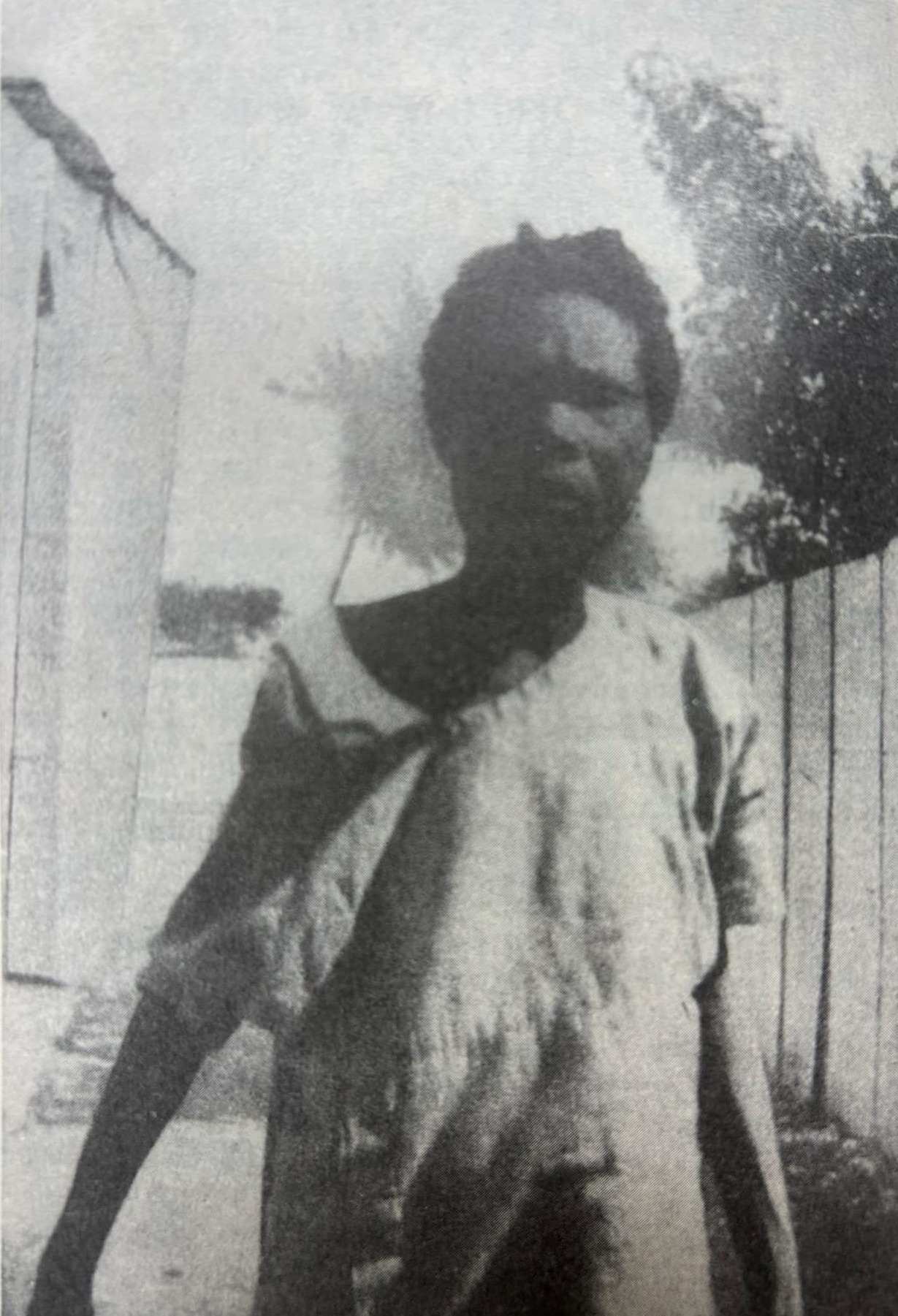
ゾンビ
ゾラ・ニール・ハーストン "Tell My Horse: Voodoo and Life in Haiti and Jamaica," 1938より
Zombie by Zora Neale Hurston

Felicia
Felix-Mentor as a Haitian Zombie from Zora Neale Hurston's "Tell My
Horse: Voodoo and Life in Haiti and Jamaica," 1938
☆ 人類学の対象としてハイチのゾンビについて考える。その題材は、ゾラ・ニール・ハーストン(1891-1960)の "Tell My Horse: Voodoo and Life in Haiti and Jamaica," 1938(邦訳『ヴードゥーの神々』常田景子、筑摩書房、2021年)である。
++++++++++++++1891 ゾラ・ニール・ハーストン生まれる(アラバマ州ノタスルガ)
1894 ハーストン一家、フロリダ州イートンヴィルに移住する
1907年 フェリシア・フェリックス=メントールは死亡し、埋葬される(ハーストン 2021:286)。
1909年10月 マリー・Mが埋葬される(ハーストン 2021:282-283)
1914年 マリー・Mがポルト・プランスの市内で目撃され、噂がかけめぐる(ハーストン 2021:283)
1929 William Seabrook, The Magic Island.
1936年3月 ゾラ・ニール・ハーストンは西インド諸島の宗教儀式の研究で、グッゲンハイム奨学金を受ける。
1936年4月〜9月 ジャマイカ滞在
1936年9月〜1937年3月 ハイチ滞在。7週間で『彼らの眼は神を見ていた』を執筆
1936年10月 フェリシア・フェリックス=メントールは「ここは父の農場だ。ここで暮らしていた」と呟き、裸で徘徊していた(→衛生局長リュルクス・レオンの診断)(レオン博士の写真は ハーストン 2021:128)
1936年冬
ハイチでの調査(Hoodoo はアメリカ南部の黒人文化の宗教、ヴードゥー(Vodou)をハイチのそれと区別)。1936年当時に、パパ・レグバの儀礼中に、供儀の鶏に触れてしまう(→1937年7月の激しい病気の原因ではないかと、後になって彼女は疑う)。
1937年1月6日 グッゲンハイム奨学金の更新を申請
1937年3月 末奨学金採択の通知がくる。その後、ハイチから米国に帰国
1937年3月〜5月 『彼らの眼は神を見ていた』の推敲?
1937年5月 グッゲンハイム奨学金が更新されハーストンはハイチに戻る。パナマの蒸気船でポルトー・プランスに到着。当時雨季。南部旅行を計画
1937年6月 「激しい病気」に襲われる(2週間)。1936年当時に、パパ・レグバの儀礼中に、供儀の鶏に触れてしまう。
1937年7月 「私のところに流れ込んでくる資料に興奮させられ、しかもたっぷり材料があるので、最終的な形にまとめる機会がなかなかつかめません」(ヘメンウェイ 1997:346)。
1937年7月中旬?——帰国まで、観光と休養でハイチで過ごす(フロリダで『わが馬に語れ』の推敲をする計画をたてる)
1937年9月 ニューヨークに帰国。9月18日発売の『彼らの眼は神を見ていた』の宣伝にはげむ。
1938年2月〜3月 『わが馬に告げよ』執筆、同年出版。ただし、売り上げは芳しくなかった(ヘメンウェイ 1997:349)。
『わ が馬に告げよ』の北米での反応:『機会』誌上、アラン・ロックは「興味津々のスリル」と「人類学的ゴシップ」と批評。人類学者たちは、それ以前の学者のも のとは一致しない。とくにメルヴィル・ハースコヴィッツは、[ハーストンが主張するゾンビをつくりあげるという]ボゴール(Bocor)はたんなる魔術師 と批判(ハーストン 2021:264-267)。
『ニューヨーカー』散 漫だが興味ふかい。『サタデーレビュー』のハロルド・クアランダー「記憶、紀行、センセーショナリズム、そして人類学などの不思議な混成体。記憶は生き生 きとし、紀行は退屈、センセーショナリズムはシーブルックの焼き直し、人類学は誤訳と素晴らしいフォークロアの混ぜ合わせだ」(ヘメンウェイ 1997:352)。
1938年4月 連邦作家計画に参加し、フロリダ州で『フロリダのニグロ』について仕事する。
++++++++++++++
| CHAPTER 13 ZOMBIES What is the whole truth and nothing else but the truth about Zombies? I do not know, but I know that I saw the broken remnant, relic, or refuse of Felicia Felix-Mentor in a hospital yard. Here in the shadow of the Empire State Building, death and the graveyard are final. It is such a positive end that we use it as a measure of nothingness and eternity. We have the quick and the dead. But in Haiti there is the quick, the dead, and then there are Zombies. This is the way Zombies are spoken of: They are the bodies without souls. The living dead. Once they were dead, and after that they were called back to life again. No one can stay in Haiti long without hearing Zombies mentioned in one way or another, and the fear of this thing and all that it means seeps over the country like a ground current of cold air. This fear is real and deep. It is more like a group of fears. For there is the outspoken fear among the peasants of the work of Zombies. Sit in the market place and pass a day with the market woman and notice how often some vendeuse cries out that a Zombie with its invisible hand has filched her money, or her goods. Or the accusation is made that a Zombie has been set upon her or some one of her family to work a piece of evil. Big Zombies who come in the night to do malice are talked about. Also the little girl Zombies who are sent out by their owners in the dark dawn to sell little packets of roasted coffee. Before sun up their cries of “Cafe grille” can be heard from dark places in the streets and one can only see them if one calls out for the seller to come with her goods. Then the little dead one makes herself visible and mounts the steps. |
第13章 ゾンビ ゾンビについて、何が真実で、何が真実以外の何ものでもないのだろうか?私にはわからないが、フェリシア・フェリックス=メントールの壊れた残骸、遺品、 あるいはゴミを病院の庭で見たことは確かだ。ここエンパイア・ステート・ビルの影では、死と墓場は最終的なものだ。それは、私たちがそれを無と永遠の尺度 として使うほど積極的な終わりである。私たちには生者と死者がいる。しかし、ハイチには生者と死者、そしてゾンビがいる。 ゾンビはこのように語られる: ゾンビは魂のない肉体である。生きている死者だ。ゾンビは魂のない死体であり、生ける屍である。 ハイチに長く滞在していると、何らかの形でゾンビについて語られるのを耳にすることがある。そして、ゾンビとそれが意味するものすべてに対する恐怖が、冷 たい空気の地上の流れのように、この国に染み込んでいく。この恐怖はリアルで深い。というより、恐怖の集合体のようなものだ。というのも、農民の間には、 ゾンビの仕業に対する率直な恐怖があるからだ。市場に座り、市場の女と一日を過ごすと、何人かの行商人が、見えない手でゾンビにお金や商品を盗まれたと叫 ぶことに気づく。あるいは、ゾンビが彼女や彼女の家族に悪事を働くように仕向けたと非難する。悪事を働くために夜にやってくる大きなゾンビの話もある。ま た、暗い夜明けに持ち主に送り出され、焙煎したコーヒーの小袋を売りに行く小さな女の子ゾンビもいる。日が昇る前に、通りの暗い場所から「カフェ・グリ ル」という彼らの叫び声が聞こえる。そして、小さな死霊は姿を現し、階段を上る。 |
| The
upper class Haitians fear too, but they do not talk about it so openly
as do the poor. But to them also it is a horrible possibility. Think of
the fiendishness of the thing. It is not good for a person who has
lived all his life surrounded by a degree of fastidious culture, loved
to his last breath by family and friends, to contemplate the
probability of his resurrected body being dragged from the vault—the
best that love and means could provide, and set to toiling ceaselessly
in the banana fields, working like a beast, unclothed like a beast, and
like a brute crouching in some foul den in the few hours allowed for
rest and food. From an educated, intelligent being to an unthinking,
unknowing beast. Then there is the helplessness of the situation.
Family and friends cannot rescue the victim because they do not know.
They think the loved one is sleeping peacefully in his grave. They may
motor past the plantation where the Zombie who was once dear to them is
held captive often and again and its soulless eyes may have fallen upon
them without thought or recognition. It is not to be wondered at that
now and then when the rumor spreads that a Zombie has been found and
recognized, that angry crowds gather and threaten violence to the
persons alleged to be responsible for the crime. Yet in spite of this obvious fear and the preparations that I found being made to safeguard the bodies of the dead against this possibility, I was told by numerous upper class Haitians that the whole thing was a myth. They pointed out that the common people were superstitious, and that the talk of Zombies had no more basis in fact than the European belief in the Werewolf. But I had the good fortune to learn of several celebrated cases in the past and then in addition, I had the rare opportunity to see and touch an authentic case. I listened to the broken noises in its throat, and then, I did what no one else had ever done, I photographed it. If I had not experienced all of this in the strong sunlight of a hospital yard, I might have come away from Haiti interested but doubtful. But I saw this case of Felicia Felix-Mentor, which was vouched for by the highest authority. So I know that there are Zombies in Haiti. People have been called back from the dead. |
ハ
イチの上流階級の人々も恐れているが、貧しい人々ほど表立っては口にしない。しかし、彼らにとってもそれは恐ろしい可能性なのだ。その恐ろしさを考えてみ
てほしい。潔癖な教養に囲まれ、家族や友人たちに最期まで愛されながら生きてきた人間が、復活した自分の肉体が、愛と手段が提供できる最高の金庫から引き
ずり出され、バナナ畑で絶え間なく働かされ、獣のように働き、獣のように服を着ず、獣のように休息と食事のために許されたわずかな時間に、どこかの汚い巣
穴でしゃがみこんでいる可能性を考えるのは、いいことではない。教育を受けた知的な存在から、何も考えず、何も知らない獣のような存在になる。そして、こ
の状況の無力さがある。家族も友人も被害者を救うことができない。彼らは愛する人が墓の中で安らかに眠っていると思っている。かつて親しかったゾンビが捕
らわれている農園を、彼らは何度も何度もモーターで通り過ぎるかもしれない。ゾンビが発見されたという噂が広まると、怒り狂った群衆が集まり、その犯罪を
犯したとされる人物に暴力を振るうと脅迫する。 しかし、このような明らかな恐怖や、このような可能性から死者を守るための準備がなされているにもかかわらず、私は多くの上流階級のハイチ人から、このよ うなことはすべて作り話だと言われた。彼らは、庶民は迷信深く、ゾンビの話はヨーロッパの狼男信仰と同じで何の根拠もないと指摘した。 しかし私は幸運にも、過去に何件かの有名な事例を知ることができ、さらに本物の事例を見たり触ったりする貴重な機会を得た。私はその喉の壊れた音に耳を傾 け、そして誰もしたことのないことをした。もし、病院の庭の強い日差しの中でこれらすべてを体験していなかったら、私はハイチから興味を持ったかもしれな いが、疑っていたかもしれない。しかし、私はこのフェリシア・フェリックス=メントールのケースを見た。ハイチにはゾンビがいる。人々は死から呼び戻され た。 |
| Now,
why have these dead folk not been allowed to remain in their graves?
There are several answers to this question, according to the case. A was awakened because somebody required his body as a beast of burden. In his natural state he could never have been hired to work with his hands, so he was made into a Zombie because they wanted his services as a laborer. B was summoned to labor also but he is reduced to the level of a beast as an act of revenge. C was the culmination of “ba’ Moun” ceremony and pledge. That is, he was given as a sacrifice to pay off a debt to a spirit for benefits received. I asked how the victims were chosen and many told me that any corpse not too old to work would do. The Bocor watched the cemetery and went back and took suitable bodies. Others said no, that the Bocor and his associates knew exactly who was going to be resurrected even before they died. They knew this because they themselves brought about the “death.” Maybe a plantation owner has come to the Bocor to “buy” some laborers, or perhaps an enemy wants the utmost in revenge. He makes an agreement with the Bocor to do the work. After the proper ceremony, the Bocor in his most powerful and dreaded aspect mounts a horse with his face toward the horse’s tail and rides after dark to the house of the victim. There he places his lips to the crack of the door and sucks out the soul of the victim and rides off in all speed. Soon the victim falls ill, usually beginning with a headache, and in a few hours is dead. The Bocor, not being a member of the family, is naturally not invited to the funeral. But he is there in the cemetery. He has spied on everything from a distance. He is in the cemetery but does not approach the party. He never even faces it directly, but takes in everything out of the corner of his eye. At midnight he will return for his victim. Everybody agrees that the Bocor is there at the tomb at midnight with the soul of the dead one. But some contend that he has it in a bottle all labelled. Others say no, that he has it in his bare hand. That is the only disagreement. The tomb is opened by the associates and the Bocor enters the tomb, calls the name of the victim. He must answer because the Bocor has the soul there in his hand. The dead man answers by lifting his head and the moment he does this, the Bocor passes the soul under his nose for a brief second and chains his wrists. Then he beats the victim on the head to awaken him further. Then he leads him forth and the tomb is closed again as if it never had been disturbed. |
では、なぜこれらの死者が墓にとどまることを許されなかったのか?この
疑問に対する答えは、ケースによっていくつかある。 Aが目覚めたのは、誰かが彼の体を重荷を負わせる獣として必要としたからだ。自然な状態では、彼は手を使って働くために雇われることはできなかったので、 労働者としての彼の役務が求められたためにゾンビにされた。Bも労働力として召喚されたが、復讐のために獣のレベルにまで堕とされる。Cは「バ'モウン」 の儀式と誓約の集大成だった。つまり、受けた恩恵に対する精霊への借りを返すための生贄として捧げられたのだ。犠牲者はどのように選ばれるのかと尋ねる と、多くの人が「働けないほど年をとっていない死体なら何でもいい」と言った。ボコールは墓地を見張り、戻っては適当な遺体を持ち帰った。また、ボコール とその仲間たちは、死ぬ前から誰が復活するかを知っていた、と言う人もいた。彼ら自身が 「死 」をもたらしたのだから。 農園主が労働者を「買う」ためにボコールのところに来たのかもしれないし、敵が最大限の復讐を望んでいるのかもしれない。彼はボコールと仕事をする契約を 結ぶ。しかるべき儀式の後、ボコールは最も強力で恐ろしい姿で馬に乗り、顔を馬の尾の方に向け、日が暮れてから被害者の家に乗り込む。そこで彼はドアの隙 間に唇を当て、被害者の魂を吸い出すと、全速力で走り去る。間もなく被害者は病気になり、たいていは頭痛で始まり、数時間で死んでしまう。ボコールは家族 の一員ではないので、当然ながら葬式には呼ばれない。しかし、彼は墓地にいる。彼は遠くからすべてを監視していた。彼は墓地にいるが、パーティには近づか ない。直接顔を合わせることもなく、目の端ですべてを観察している。真夜中、彼は犠牲者のために戻ってくる。 真夜中、ボコールは死んだ者の魂とともに墓にいる、というのは誰もが認めるところだ。しかしある者は、ボコールはラベルを貼った瓶の中に魂を持っていると 主張する。また、そうではなく、素手で持っていると言う者もいる。それが唯一の意見の相違点である。ボコールは墓に入り、犠牲者の名前を呼ぶ。ボコールは 魂を手に持っているのだから、彼は答えなければならない。死者は頭を上げて答えるが、その瞬間、ボコールは一瞬だけ魂を鼻の下に通し、手首を鎖で縛る。そ して、被害者の頭を叩いてさらに目を覚まさせる。そして、彼を外に連れ出すと、墓は再び閉ざされ、何事もなかったかのようになる。 |
| The
victim is surrounded by the associates and the march to the hounfort
(Voodoo temple and its surroundings) begins. He is hustled along in the
middle of the crowd. Thus he is screened from prying eyes to a great
degree and also in his half-waking state he is unable to orientate
himself. But the victim is not carried directly to the hounfort. First
he is carried past the house where he lived. This is always done. Must
be. If the victim were not taken past his former house, later on he
would recognize it and return. But once he is taken past, it is gone
from his consciousness forever. It is as if it never existed for him.
He is then taken to the hounfort and given a drop of a liquid, the
formula for which is most secret. After that the victim is a Zombie. He
will work ferociously and tirelessly without consciousness of his
surroundings and conditions and without memory of his former state. He
can never speak again, unless he is given salt. “We have examples of a
man who gave salt to a demon by mistake and he come man again and can
write the name of the man who gave him to the loa,” Jean Nichols told
me and added that of course the family of the victim went straight to a
Bocor and “gave” the man who had “given” their son. Now this “Ba Moun” (give man) ceremony is a thing much talked about in Haiti. It is the old European belief in selling one’s self to the devil but with Haitian variations. In Europe the man gives himself at the end of a certain period. Over in Haiti he gives others and only gives himself when no more acceptable victims can be found. But he cannot give strangers. It must be a real sacrifice. He must give members of his own family or most intimate friends. Each year the sacrifice must be renewed and there is no avoiding the payments. There are tales of men giving every member of the family, even his wife after nieces, nephews, sons and daughters were gone. Then at last he must go himself. There are lurid tales of the last days of men who have gained wealth and power thru “give man.” The wife of one man found him sitting apart from the family weeping. When she demanded to know the trouble, he told her that he had been called to go, but she was not to worry because he had put everything in order. He was crying because he had loved her very much and it was hard to leave her. She pointed out that he was not sick and of course it was ridiculous for him to talk of death. Then with his head in her lap he told her about the “services” he had made to obtain the advantages he had had in order to surround her with increasing comforts. Finally she was the only person left that he could offer but he would gladly die himself rather than offer her as a sacrifice. He told her of watching the day of the vow come and go while his heart grew heavier with every passing hour. The second night of the contract lapsed and he heard the beasts stirring in their little box. The third night which was the one just past, a huge and a terrible beast had emerged in the room. If he could go to the Bocor that same day with a victim, he still could go another year at least. But he had no one to offer except his wife and he had no desire to live without her. He took an affectionate farewell of her, shut himself in his own room and continued to weep. Two days later he was dead. |
被
害者は仲間に取り囲まれ、ホウンフォート(ヴードゥー教寺院とその周辺)への行進が始まる。被害者は群衆の真ん中に連れて行かれる。こうして彼は詮索好き
な目からかなりの程度遮られ、また半覚醒状態で自分の方向が定まらない。しかし、被害者は直接家まで運ばれるわけではない。まず、被害者が住んでいた家の
前を通って運ばれる。これは必ず行われる。必ずだ。もし被害者が元の家の前を通って運ばれなかったら、後になってその家に気づいて戻るだろう。しかし一度
通り過ぎると、そこは彼の意識から永遠に消えてしまう。まるで存在しなかったかのように。その後、彼は病院に連れて行かれ、ある液体を一滴飲まされる。そ
の後、被害者はゾンビとなる。周囲の環境や状況を意識することなく、以前の状態の記憶もなく、猛烈に疲れ知らずで働く。塩を与えない限り、二度と話すこと
はできない。「間違って悪魔に塩を与えた男が、再び人間に戻り、ロアに塩を与えた男の名前を書けるようになった例がある」とジャン・ニコルズは私に話し、
もちろん被害者の家族はボコールに直行し、息子を「与えた」男を「与えた」と付け加えた。 さて、この「バ・モウン」(男を与える)の儀式は、ハイチではよく話題になる。悪魔に自分の身を売るというヨーロッパでは古くからある信仰だが、ハイチで はさまざまなバリエーションがある。ヨーロッパでは、男は一定の期間が終わると自分を捧げる。ハイチでは他人に捧げ、それ以上受け入れられる犠牲者が見つ からなくなったときだけ自分を捧げる。しかし、他人を捧げることはできない。本当の犠牲でなければならない。自分の家族や親しい友人を犠牲にしなければな らない。毎年、犠牲は更新されなければならず、その支払いを避けることはできない。姪や甥、息子や娘がいなくなった後、家族全員を、妻までもを捧げたとい う話もある。そして最後には、彼自身が行かなければならない。「ギブ・マン "を通して富と権力を手に入れた男たちの最期の薄気味悪い話がある。 ある男の妻が、彼が家族から離れて座って泣いているのを見つけた。妻が何があったのかと尋ねると、彼は「召されて行くことになった。彼は彼女をとても愛し ていたので、離れるのが辛くて泣いていたのだ。彼女は、彼が病気ではないことを指摘し、もちろん彼が死の話をするのは馬鹿げていると言った。そして、彼女 の膝に頭を乗せながら、彼女をますます快適な生活で包むために、自分が手に入れた利点を得るためにした「奉仕」について話した。最終的に、彼女だけが彼に 残された唯一の人であったが、彼女を生け贄として捧げるくらいなら、喜んで自分が死のうと思った。時間を追うごとに心が重くなるのを感じながら、彼は誓い の日が過ぎ去っていくのを見送った。契約から2日目の夜が過ぎ、彼は獣たちが小さな箱の中で蠢く音を聞いた。そして3日目の夜、巨大で恐ろしい獣が部屋に 現れた。もしその日のうちに犠牲者を連れてボコールに行くことができれば、少なくともあと1年は生きられるだろう。しかし、彼には妻以外には誰もいない し、妻なしで生きる気もなかった。彼は妻に別れを告げ、自分の部屋に閉じこもり、泣き続けた。2日後、彼は死んだ。 |
| Another
man received the summons late one night. Bosu Tricorne, the terrible
three-horned god, had appeared in his room and made him know that he
must go. Bosu Tricorne bore a summons from Baron Cimiterre, the lord of
the cemetery. He sprang from his bed in terror and woke up his family
by his fear noises. He had to be restrained from hurling himself out of
the window. And all the time he was shouting of the things he had done
to gain success. Naming the people he had given. The family in great
embarrassment dragged him away from the window and tried to confine him
in a room where his shouts could not be heard by the neighbors. That
failing, they sent him off to a private room in a hospital where he
spent two days confessing before he died. There are many, many tales
like that in the mouths of the people. There is the story of one man of great courage who, coming to the end of his sacrifices, feeling that he had received what he bargained for, went two days ahead and gave himself up to the spirit to die. But the spirit so admired his courage that he gave him back all of the years he had bargained to take. Why do men allegedly make such bargains with the spirits who have such terrible power to reward and punish? When a man is ambitious and sees no way to get there, he becomes desperate. When he has nothing and wants prosperity he goes to a houngan and says, “I have nothing and I am disposed to do anything to have money.” The houngan replies, “He who does not search, does not find.” “I have come to you because I wish to search,” the man replies. “Well, then,” the houngan says, “we are going to make a ceremony, and the loa are going to talk with you.” The houngan and the man go into the hounfort. He goes to a small altar and makes the symbol with ashes and gunpowder (indicating that it is a Petro invocation), pours the libation and begins to sing with the Ascon and then asks the seeker, “What loa you want me to call for you?” The man makes his choice. Then the houngan begins in earnest to summon the loa wanted. No one knows what he says because he is talking “langage” that is, language, a way of denoting the African patter used by all houngans for special occasions. The syllables are his very own, that is, something that cannot be taught. It must come to the priest from the loa. He calls many gods. Then the big jars under the table that contain spirits of houngans long dead begin to groan. These spirits in jars have been at the bottom of the water for a long time. The loa was not taken from their heads at death and so they did not go away from the earth but went to the bottom of the water to stay until they got tired and demanded to be taken out. All houngans have one more of these spirit jars in the hounfort. Some have many. The groaning of the jars gets louder as the houngan keeps calling. Finally one jar speaks distinctly, “Pourquoi ou derange’ moi?” (Why do you disturb me?) The houngan signals the man to answer the loa. So he states his case. |
あ
る夜遅く、別の男が召集令状を受け取った。恐ろしい三本角の神、ボス・トリコーネが彼の部屋に現れ、行かなければならないことを告げたのだ。ボス・トリ
コーネは、墓地の主であるシミテール男爵からの召喚状を携えていた。彼は恐怖のあまりベッドから飛び起き、恐怖の声で家族を起こした。窓から飛び降りるの
を止めなければならなかった。その間も彼は、自分が成功を得るためにしてきたことを叫び続けた。自分が与えた人々の名前を挙げていた。大恥をかいた家族
は、彼を窓から引き離し、彼の叫び声が隣人に聞こえないような部屋に閉じ込めようとした。しかし、それは失敗に終わり、彼は病院の個室に送られ、そこで死
ぬまでの2日間を告白に費やした。人々の口には、そのような話がたくさんある。 ある偉大な勇気のある男の話もある。彼は、犠牲の果てに、自分が値切ったものを受け取ったと感じ、2日前に行って、霊に身を委ねて死んだ。しかし、霊は彼 の勇気に感服し、約束した年数をすべて返したという。 なぜ人は、報いも罰も与える恐ろしい力を持つ霊とそのような交渉をするのだろうか? 人は野心に燃えているが、そこに至る道が見えないとき、自暴自棄になる。何も持っておらず、繁栄が欲しいとき、彼は法眼のところへ行き、こう言う。 ホンガンはこう答えた。「探さない者は見つからない。 「私は探したいからあなたのところに来たのです」と男は答えた。 「では、儀式を行い、ロアがあなたと話すことにしましょう」。 ホウンガンと男は小屋に入った。彼は小さな祭壇に向かい、灰と火薬でシンボルを作り(それがペトロの呼びかけであることを示す)、酒を注ぎ、アスコンと歌 い始める。 と尋ねる。そして、ホウンガンは本格的にそのロアを召喚し始める。なぜなら、彼は「ランガージュ」、つまり特別な時にすべてのフンガンが使うアフリカのパ タ-を表す言葉を話しているからだ。その音節は彼独自のものであり、教えることのできないものである。ロアから神父に伝授されるのだ。彼は多くの神々を呼 ぶ。そして、テーブルの下に置かれた大きな壺がうめき始める。甕の中の霊魂たちは長い間、水の底にいた。死んでも頭からロアを取り出さなかったので、地上 から去ることなく水の底に行き、疲れて取り出すことを要求するまで留まっていたのだ。すべてのフーガンは、この精霊瓶をもう一つ持っている。たくさんある ところもある。ハウンガンが呼び続けると、甕のうめき声が大きくなる。ついに1つの壷が「Pourquoi ou derange' moi(なぜ私を邪魔するのか)」とはっきりと話す。そこで彼は自分の主張を述べる。 |
| “Papa,
loa, ou mem, qui connais toute baggage ou mem qui chef te de l’eau, moi
duange’ on pour mande’ ou servir moi.” (Papa, loa, yourself, who knows
all things, you yourself who is master of waters, I disturb you to ask
you to serve me.) The Voice: Ma connasis ca on besoin. Mais, on dispose pour servir moi aussi? (I know what you want, but are you disposed to serve me also?) The Man: Yes, command me what you want. Voice: I am going to give you all that you want, but you must make all things that I want. Write your name in your own blood and put the paper in the jar. The houngan, still chanting, pricks the man’s finger so sharply that he cries out. The blood flows and the supplicant dips a pen in it and writes his name and puts the paper in the jar. The houngan opens a bottle of rum and pours some in the jar. There is the gurgling sound of drinking. The Voice: And now I am good (I do good) for you. Now I tell you what you must do. You must give me someone that you love. Today you are going into your house and stay until tomorrow. On the eighth day you are returning here with something of the man that you are going to give me. Come also with some money in gold. The voice ceases. The houngan finishes presently, after repeating everything that the Voice from the jar has said, and dismisses the man. He goes away and returns on the day appointed and the houngan calls up the loa again. The Voice: Are you prepared for me? The Man: Yes. The Voice: Have you done all that I told you? The Man: Yes. The Voice (to houngan): Go out. (to man) Give me the gold money. (The man gives it.) The Voice: Now, you belong to me and I can do with you as I wish. If I want you in the cemetery I can put you there. The Man: Yes, I know you have all power with me. I put myself in your care because I want prosperity. The Voice: That I will give you. Look under the table. You will find a little box. In this box there are little beasts. Take this little box and put it in your pocket. Every eighth day you must put in it five hosts (Communion wafers). Never forget to give the hosts. Now, go to your house and put the little box in a big box. Treat it as if it were your son. It is now your son. Every midnight open the box and let the beasts out. At four o’clock he will return and cry to come in and you will open for him and close the box again. And every time you give the beasts the communion, immediately after, you will receive large sums of money. Each year on this date you will come to me with another man that you wish to give me. Also you must bring the box with the beasts. If you do not come, the third night after the date, the beasts in the box will become great huge animals and execute my will upon you for your failure to keep your vow. If you are very sick on that day that the offering falls due say to your best friend that he must bring the offering box for you. Also you must send the name of the person you intend to give me as pay for working for you and he must sign a new contract with me for you. |
「Papa,
loa, ou mem, qui connais toute baggage ou mem qui chef te de l'eau, moi
duange' on pour mande' ou servir moi."
(パパ、ロア、あなた自身、すべての荷物を知っている、水の主であるあなた自身、私はあなたに私に仕えるように頼むために邪魔をする。)
(パパ、ロア、すべてを知るあなた自身、水の主であるあなた自身、私はあなたに私に仕えてもらうために邪魔をする) 声: マ・コナシス・カ・オン・ベソワン。しかし、あなたは私に仕える気もあるのか? 男:そうだ、君の望むものを私に命じてくれ。 声:私はあなたの望むものをすべて与えるつもりだが、あなたは私の望むものをすべて作らなければならない。自分の名前を自分の血で書き、その紙を壺に入れ るのだ。 フンガンはまだ唱えながら、男の指を鋭く刺し、泣き叫ぶ。血が流れ、その中にペンを浸して自分の名前を書き、その紙を壺に入れる。フンガンはラム酒の瓶を 開け、瓶に注ぐ。ゴクゴクと飲む音がする。 声だ: そして今、私はあなたにとって良い存在である。さあ、何をすべきか教えてあげよう。あなたは愛する人を私に与えなければならない。今日、あなたは自分の家 に入り、明日まで滞在する。八日目に、あなたは私にくれる人の何かを持ってここに戻るのだ。金貨も持って来なさい」。声がやむ。フンガンは、壷の中から聞 こえてきた声をすべて繰り返した後、その男を追い払った。彼は立ち去り、約束の日に戻ってくると、ハウンガンは再びロアを呼び出す。 声だ: 準備はできたか? 男:はい。 声:言ったことは全部やったか? 男:はい。 男:はい: 出て行け。(男に向かって)金を出せ。 (男は金を渡す) 声: おまえは俺のものだ。墓地に入れたければ、そこに入れるよ。 男:ああ、君が僕に対してすべての権限を持っていることは知っている。私は繁栄が欲しいから、あなたの世話になるんだ。 声:それは私が与えよう。テーブルの下を見てごらん。小さな箱がある。この箱の中に小さな獣がいる。この小さな箱を持ってポケットに入れなさい。8日ごと に、その中に5枚の聖体を入れなければならない。聖体を捧げることを決して忘れてはならない。さあ、自分の家に行き、その小さな箱を大きな箱に入れなさ い。自分の息子のように扱いなさい。それが今、あなたの息子なのだ。真夜中ごとに箱を開け、獣を外に出す。4時になると息子が戻って来て、中に入りたいと 泣くので、あなたは息子のために箱を開け、また箱を閉める。そして、獣に聖餐を与えるたびに、その直後、あなたは大金を受け取るだろう。毎年この日に、あ なたは私に与えたい別の男を連れて私のところに来るのだ。また、獣の入った箱も持参すること。もしあなたが来なければ、その日から3日目の夜、箱の中の獣 は巨大な獣となり、あなたが誓いを守らなかったことに対して、私の意志をあなたに実行する。もし供え物が届くその日にあなたが重病なら、あなたの親友に、 あなたのために供え物箱を持ってくるようにと言いなさい。また、あなたのために働いた報酬として私に渡すつもりである人物の名前を送り、その人物はあなた のために私と新たな契約を結ばなければならない。 |
| All
is finished between the Voice and the man. The houngan reenters and
sends the man away with assurance that he will commence the work at
once. Alone he makes ceremony to call the soul of the person who is to
be sacrificed. No one would be permitted to see that. When the work in
the hounfort is finished, then speeds the rider on the horse. The rider
who faces backwards on the horse, who will soon place his lips to the
crack of the victim’s door and draw his soul away. Then will follow the
funeral and after that the midnight awakening. And the march to the
hounfort for the drop of liquid that will make him a Zombie, one of the
living dead. Some maintain that a real and true priest of Voodoo, the houngan, has nothing to do with such practices. That it is the bocor and priests of the devil—worshipping cults—who do these things. But it is not always easy to tell just who is a houngan and who is a bocor. Often the two offices occupy the same man at different times. There is no doubt that some houngans hold secret ceremonies which their usual following know nothing of. It would be necessary to investigate every houngan and bocor in Haiti rigidly over a period of years to determine who was purely houngan and who was purely bocor. There is certainly some overlapping in certain cases. A well known houngan of Leogane, who has become a very wealthy man by his profession is spoken of as a bocor more often than as a houngan. There are others in the same category that I could name. Soon after I arrived in Haiti a young woman who was on friendly terms with me said, “You know, you should not go around alone picking acquaintances with these houngans. You are liable to get involved in something that is not good. You must have someone to guide you.” I laughed it off at the time, but months later I began to see what she was hinting at. What is involved in the “give man” and making of Zombies is a question that cannot be answered anywhere with legal proof. Many names are called. Most frequently mentioned in this respect is the Man of Trou Forban. That legendary character who lives in the hole in the mountain near St. Marc. He who has enchanted caves full of coffee and sugar plantations. The entrance to this cave or this series of caves is said to be closed by a huge rock that is lifted by a glance from the master. The Marines are said to have blown up this great rock with dynamite at one time, but the next morning it was there whole and in place again. When the master of Trou Forban walks, the whole earth trembles. There are tales of the master and his wife, who is reputed to be a greater bocor than he. She does not live with him at Trou Forban. She is said to have a great hounfort of her own on the mountain called Tapion near Petit Gouave. She is such a great houngan that she is honored by Agoue’ te Royo, Maitre l’eau, and walks the waters with the same ease that others walk the earth. But she rides in boats whenever it suits her fancy. One time she took a sailboat to go up the coast near St. Marc to visit her husband, Vixama. She appeared to be an ordinary peasant woman and the captain paid her no especial attention until they arrived on the coast below Trou Forban. Then she revealed herself and expressed her great satisfaction with the voyage. She felt that the captain had been extremely kind and courteous, so she went to call her husband to come down to the sea to meet him. Realizing now who she was, the captain was afraid and made ready to sail away before she could return from the long trip up the mountain. But she had mounted to the trou very quickly and returned with Vixama to find the captain and his crew poling the boat away from the shore in the wildest terror. The wind was against them and they could not sail away. Mme. Vixama smiled at their fright and hurled two grains of corn which she held in her hand on to the deck of the boat and they immediately turned into golden coin. The captain was more afraid and hastily brushed them into the sea. They sailed south all during the night, much relieved that they had broken all connections with Vixama and his wife. But at first light the next morning he found four gold coins of the same denomination as the two that he had refused the day before. Then he knew that the woman of Vixama had passed the night on board and had given them a good voyage as well—the four gold coins were worth twenty dollars each. |
声
と男の間ですべてが終わった。ホウガンが再び入り、すぐに作業を開始することを保証して男を送り出す。彼は一人で、生贄となる人の魂を呼び出す儀式を行
う。それを見ることは誰にも許されない。砦での作業が終わると、馬に乗った騎手がスピードを上げる。馬上で後方を向いた騎手は、すぐに犠牲者の扉の隙間に
唇を当て、魂を引き離す。その後、葬儀が行われ、真夜中の目覚めが待っている。そして生ける屍の一人であるゾンビになるための一滴の液体を求めて、葬儀場
へと行進する。 ヴードゥー教の真の司祭であるフンガンは、このような習慣とは無関係だと主張する人もいる。悪魔を崇拝するカルトのボコールや司祭がこのようなことを行っ ているのだ。しかし、誰がホウンガンで誰がボコールなのかを見分けるのは必ずしも容易ではない。この2つの役職が同じ人物に就いていることもしばしばあ る。一部のフーガンが、普段は何も知らない秘密の儀式を行っていることは間違いない。誰が純粋にハウガンであり、誰が純粋にボコールであるかを決定するた めには、何年にもわたってハイチのすべてのハウガンとボコールを厳密に調査する必要がある。確かに重複しているケースもある。レオガンのある有名なフンガ ンは、その職業によって大金持ちになったが、フンガンとしてよりもボコールとして語られることが多い。同じような人は他にもいる。私がハイチに到着して間 もなく、親しくしていた若い女性が言った。良くないことに巻き込まれる可能性がある。指導してくれる人が必要だ "と言われた。そのときは笑って受け流したが、数ヵ月後、彼女が何をほのめかしているのかがわかるようになった。 ゾンビの「ギブマン」と製造に何が関わっているのかは、法的な証拠をもってしてもどこにも答えられない問題である。多くの名前が挙げられている。この点で 最も頻繁に言及されるのは、「トルー・フォーバンの男」である。サンマルク近くの山の穴に住んでいる伝説的な人物だ。コーヒーと砂糖のプランテーションで いっぱいの洞窟に魔法をかけている。この洞窟、あるいは一連の洞窟の入り口は、主人の視線によって持ち上げられる巨大な岩によって閉じられていると言われ ている。海兵隊はこの大岩をダイナマイトで爆破したというが、翌朝には丸ごと元の位置に戻っていた。トロウ・フォルバンのマスターが歩くと、地球全体が震 える。主人と、主人よりも偉大なボコールと評判の妻の話がある。彼女はトルー・フォルバンで主人とは暮らしていない。彼女は、プティ・グアブの近くのタピ オンと呼ばれる山に、自分の大きな屋敷を持っていると言われている。彼女は、アグエ・テ・ロワイヨから 「Maitre l'eau 」の称号を授かるほどの偉大なホウガンであり、他の者が大地を歩くのと同じように容易に水面を歩く。しかし、彼女は気が向けばいつでもボートに乗る。ある 時、彼女は夫のヴィクサマを訪ねるために、サンマルク近くの海岸に行くためにヨットに乗った。彼女は普通の農民の女性に見えたので、船長はトルー・フォル バンの下の海岸に着くまで特別な注意を払わなかった。その後、彼女は正体を現し、航海に大満足していることを告げた。彼女は、船長が非常に親切で礼儀正し かったと感じ、夫に会いに海まで降りてくるよう呼びに行った。船長は彼女が何者であるかを知り、恐れおののき、彼女が長い山登りから戻る前に出航しようと した。しかし、彼女はすぐにトロウに乗り込み、ヴィクサマと一緒に戻ってくると、船長と乗組員たちが荒々しい恐怖の中で岸から船を漕ぎ出していた。風は逆 風で、船を走らせることはできなかった。ヴィクサマ夫人は彼らの恐怖に微笑み、手に持っていた2粒のトウモロコシを船の甲板に投げつけると、それはたちま ち金貨に変わった。船長はさらに恐れ、急いでそれを海に流した。ヴィクサマ夫妻との縁が切れたことに安堵しながら、船は一晩中南へ航行した。しかし、翌朝 の明け方、船長は前日に断った2枚の金貨と同じ額面の金貨を4枚見つけた。4枚の金貨はそれぞれ20ドルの価値があった。 |
| There
are endless tales of the feats of the occupant of this hole high up on
this inaccessible mountain. But in fact it has yet to be proved that
anyone has ever laid eyes on him. He is like the goddess in the volcano
of Hawaii, and Vulcan in Mt. Vesuvius. It is true that men, taking
advantage of the legend and the credulous nature of the people, have
set up business in the mountain to their profit. The name of this Man
of Trou Forban is known by few and rarely spoken by those who know it.
This whispered name is Vixama, which in itself means invisible spirit.
He who sits with a hive of honey-bees in his long flowing beard. It is
he who is reputed to be the greatest buyer of souls. His contact man is
reputed to be Mardi Progres. But we hear too much about the practice
around Archahaie and other places to credit Trou Forban as the
headquarters. Some much more accessible places than the mountain top is
the answer. And some much more substantial being than the invisible
Vixama. If embalming were customary, it would remove the possibility of Zombies from the minds of the people. But since it is not done, many families take precautions against the body being disturbed. Some set up a watch in the cemetery for thirty-six hours after the burial. There could be no revival after that. Some families have the bodies cut open, insuring real death. Many peasants put a knife in the right hand of the corpse and flex the arm in such a way that it will deal a blow with the knife to whoever disturbs it for the first day or so. But the most popular defense is to poison the body. Many of the doctors have especially long hypodermic needles for injecting a dose of poison into the heart, and sometimes into other parts of the body as well. A case reported from Port du Paix proves the necessity of this. In Haiti if a person dies whose parents are still alive, the mother does not follow the body to the grave unless it is an only child. Neither does she wear mourning in the regular sense. She wears that coarse material known as “gris-blanc.” The next day after the burial, however, she goes to the grave to say her private farewell. |
こ
の近づきがたい山の高いところにある穴の住人の偉業については、果てしない物語がある。しかし実際には、誰も彼を目にしたことがないと証明されている。彼
はハワイの火山の女神やヴェスヴィオ山のバルカンのようなものだ。この伝説と人々の信心深さにつけこんで、この山で商売を始め、利益を得ている人々がいる
のは事実である。このトルー・フォルバンの男の名は、知る者は少なく、知る者が口にすることはめったにない。囁かれているその名はヴィクサマといい、それ
自体は目に見えない精霊を意味する。長く流れる髭の中にミツバチの巣を抱え、座っている。魂の最大の買い手と評判の男だ。彼のコンタクトマンはマルディ・
プログレスと言われている。しかし、トルー・フォルバンを本部として信用するには、アーチャハイや他の場所での実践について聞きすぎる。山の頂上よりも
もっとアクセスしやすい場所が答えなのだ。そして、目に見えないヴィクサマよりもずっと実質的な存在もいる。 もしエンバーミングの習慣があれば、人々の心からゾンビの可能性を取り除くことができるだろう。しかし、エンバーミングが行われていないため、多くの家族 は遺体が邪魔にならないように用心している。 埋葬後36時間、墓地に見張りを立てるところもある。それ以後は蘇生はありえない。遺体を切り開いて、本当の死を保証する家もある。多くの農民は、死体の 右手にナイフを刺し、最初の1日くらいは、死体を乱す者にナイフで一撃を与えるように腕を曲げる。しかし、最もポピュラーな防御法は、死体を毒殺すること である。医師の多くは、心臓や、時には体の他の部分に毒を注射するための、特に長い皮下注射針を持っている。 ポート・デュ・ペで報告された事例が、その必要性を証明している。ハイチでは、両親がまだ生きている人が亡くなった場合、一人っ子でない限り、母親は遺体 を墓まで追いかけない。通常の喪服も着ない。母親は 「グリ・ブラン 」と呼ばれる粗い服を着る。しかし、埋葬の翌日、母親は墓に行き、自分だけの別れを告げる。 |
| In
the following case everything had seemed irregular. The girl’s sudden
illness and quick death. Then, too, her body stayed warm. So the family
was persuaded that her death was unnatural and that some further use
was to be made of her body after burial. They were urged to have it
secretly poisoned before it was interred. This was done and the funeral
went off in routine manner. The next day, like Mary going to the tomb of Jesus, the mother made her way to the cemetery to breathe those last syllables that mothers do over their dead, and like Mary she found the stones rolled away. The tomb was open and the body lifted out of the coffin. It had not been moved because it was so obviously poisoned. But the ghouls had not troubled themselves to rearrange things as they were. Testimony regarding Zombies with names and dates come from all parts of Haiti. I shall cite a few without using actual names to avoid embarrassing the families of the victims. In the year 1898 at Cap Haitian a woman had one son who was well educated but rather petted and spoiled. There was some trouble about a girl. He refused to accept responsibility and when his mother was approached by a member of the girl’s family she refused to give any sort of satisfaction. Two weeks later the boy died rather suddenly and was buried. Several Sundays later the mother went to church and after she went wandering around the town—just walking aimlessly in her grief, she found herself walking along Bord Mer. She saw some laborers loading ox carts with bags of coffee and was astonished to see her son among these silent workers who were being driven to work with ever increasing speed by the foreman. She saw her son see her without any sign of recognition. She rushed up to him screaming out his name. He regarded her without recognition and without sound. By this time the foreman tore her loose from the boy and drove her away. She went to get help, but it was a long time and when she returned she could not find him. The foreman denied that there had ever been anyone of that description around. She never saw him again, though she haunted the water front and coffee warehouses until she died. |
次
のケースでは、すべてが不規則に思えた。少女の突然の病死である。しかも遺体は温かいままだった。そこで遺族は、彼女の死は不自然であり、埋葬後に遺体を
さらに利用する必要があると説得した。遺体を埋葬する前に、密かに毒殺するよう勧めた。これが実行され、葬儀は日常的に行われた。 翌日、イエスの墓に向かうマリアのように、母親も墓地に向かい、母親が死者にする最後の挨拶をした。墓は開かれ、遺体は棺から持ち上げられていた。明らか に毒殺されていたため、死体は動かされていなかった。しかし、グールたちは、そのままの状態で並べ替えようとはしなかった。 ゾンビに関する名前と日付入りの証言はハイチ各地から寄せられている。犠牲者の家族を困らせないために、実名は伏せていくつか引用する。 1898年、ある女性がキャップ・ハイティアンで一人の息子を産んだ。その息子はよく教育されていたが、むしろ愛玩され、甘やかされていた。ある女の子の ことでトラブルがあった。息子は責任を取ろうとせず、母親が少女の家族から話を持ちかけられたとき、母親は満足のいく説明をすることを拒んだ。2週間後、 その少年は急死し、埋葬された。数日後の日曜日、母親は教会に行き、悲しみに暮れながら町をぶらぶらと歩いた。労働者たちが牛車にコーヒーの入った袋を積 んでいるのを見た彼女は、現場監督によってどんどんスピードを上げて仕事に駆り出される無言の労働者たちのなかに息子がいるのを見て驚いた。彼女は、息子 が自分を見ているのを見た。彼女は息子の名前を叫びながら駆け寄った。しかし、息子は何の認識もなく、声も出さずに彼女を見た。その頃、現場監督は彼女を 少年から引き離し、追い払った。彼女は助けを呼びに行ったが、長い時間がかかり、戻ってきても彼を見つけることはできなかった。現場監督は、そのような人 物はいなかったと否定した。彼女は死ぬまでウォーターフロントやコーヒー倉庫に出没したが、それ以来彼に会うことはなかった。 |
| A
white Protestant missionary minister told me that he had a young man
convert to his flock who was a highly intelligent fellow and a clever
musician. He went to a dance and fell dead on the floor. The missionary
conducted the funeral and saw the young man placed in the tomb and the
tomb closed. A few weeks later another white minister of another
Protestant denomination came to him and said, “I had occasion to visit
the jail and who do you suppose I saw there? It was C. R.” “But it is not possible. C. R. is dead. I saw him buried with my own eyes.” “Well, you just go down to the prison and see for yourself. He is there, for nobody knows I saw him. After I had talked with a prisoner I went there to see, I passed along the line of cells and saw him crouching like some wild beast in one of the cells. I hurried here to tell you about it.” The former pastor of C. R. hurried to the prison and made some excuse to visit in the cell block. And there was his late convert, just as he had been told. This happened in Port-au-Prince. Then there was the case of P., also a young man. He died and was buried. The day of the funeral passed and the mother being so stricken some friends remained overnight in the house with her and her daughter. It seems that the sister of the dead boy was more wakeful than the rest. Late in the night she heard subdued chanting, the sound of blows in the street approaching the house and looked out of the window. At the moment she did so, she heard the voice of her brother crying out: “Mama! Mama! Sauvez moi!” (Save me!) She screamed and aroused the house and others of the inside looked out and saw the procession and heard the cry. But such is the terror inspired by these ghouls, that no one, not even the mother or sister, dared go out to attempt a rescue. The procession moved on out of sight. And in the morning the young girl was found to be insane. But the most famous Zombie case of all Haiti is the case of Marie M. It was back in October 1909 that this beautiful young daughter of a prominent family died and was buried. Everything appeared normal and people generally forgot about the beautiful girl who had died in the very bloom of her youth. Five years passed. Then one day a group of girls from the same school which Marie had attended went for a walk with one of the Sisters who conducted the school. As they passed a house one of the girls screamed and said that she had seen Marie M. The Sister tried to convince her she was mistaken. But others had seen her too. The news swept over Port-au-Prince like wild fire. The house was surrounded, but the owner refused to let anyone enter without the proper legal steps. The father of the supposedly dead girl was urged to take out a warrant and have the house searched. This he refused to do at once. Finally he was forced to do so by the pressure of public opinion. By that time the owner had left secretly. There was no one nor nothing in the house. The sullen action of the father caused many to accuse him of complicity in the case. Some accused her uncle and others her god father. And some accused all three. The public clamored for her grave to be opened for inspection. Finally this was done. A skeleton was in the coffin but it was too long for the box. Also the clothes that the girl had been buried in were not upon the corpse. They were neatly folded beside the skeleton that had strangely outgrown its coffin. |
あ
るプロテスタントの白人宣教師が、自分の群れに改宗してきた青年がいた、と言っていた。彼はダンスに行き、床に倒れて死んだ。宣教師は葬儀を執り行い、そ
の若者が墓に納められ、墓が閉じられるのを見た。数週間後、別のプロテスタント宗派の白人牧師が彼のもとを訪れ、「刑務所を訪れる機会があったのだが、そ
こで誰を見たと思う?C・Rだった。 「しかし、そんなことはあり得ない。C.R.は死んだ。私はこの目で彼が埋葬されているのを見たんだ」。 「刑務所に行き、自分の目で確かめればいい。私が見たことは誰も知らない。ある囚人と話をした後、監房の列を通りかかると、彼が野獣のように監房の一角に しゃがみ込んでいた。そのことを話すために急いでここに来たんだ」。 C.R.の元牧師は急いで刑務所に行き、何か口実を作って独房棟を訪ねた。するとそこには、言われたとおりの亡くなった改宗者がいた。これはポルトープラ ンスで起こったことだ。Pのケースもあった。彼は亡くなり、埋葬された。葬儀の日は過ぎ、母親はとても苦しんでいたので、何人かの友人が母親と娘の家に一 晩泊まった。死んだ男の子の妹は、他の人たちよりも目が覚めていたようだった。夜遅く、彼女は控えめなお経を聞き、通りから家に近づく打撃音を聞き、窓か ら外を見た。その瞬間、彼女は弟の泣き叫ぶ声を聞いた: 「ママ!ママ!ママ!彼女は悲鳴を上げ、家の中を奮い立たせ、中にいた人たちが外を見ると、行列が見え、叫び声が聞こえた。しかし、グールたちの恐怖に怯 え、母親も妹も、誰も外に出て救助を試みる勇気がなかった。行列はそのまま見えなくなった。そして朝になると、少女は正気を失っていることがわかった。 1909年10月、名家の若く美しい娘が亡くなり、埋葬された。すべてが正常に見え、人々は青春の真っ盛りに死んだ美しい娘のことを忘れていた。それから 5年が過ぎた。 ある日、マリーが通っていた学校の女子生徒たちが、その学校を運営するシスターの一人と散歩に出かけた。ある家を通りかかったとき、一人の少女が悲鳴を上 げて、マリー・Mを見たと言った。しかし、他の人たちもマリーを目撃していた。そのニュースはポルトープランスを火のように駆け巡った。家は包囲された が、所有者は適切な法的手続きなしに誰も立ち入らせることを拒否した。死んだと思われる少女の父親は、令状を取って家を捜索するよう促された。彼はすぐに それを拒否した。しかし、世論の圧力に押され、やむなく家宅捜索をすることになった。その頃、所有者は密かに家を出ていた。家には誰もおらず、何もなかっ た。父親の不機嫌な態度は、多くの人に事件への加担を非難させた。ある者は叔父を、またある者は神父を非難した。そしてある者は3人全員を非難した。世間 は、彼女の墓を開けて検査するよう求めた。ついにそれが実現した。棺には骸骨が入っていたが、箱には長すぎた。また、少女が埋葬されていた衣服は死体の上 にはなかった。棺からはみ出した骸骨の横に、きちんとたたまれていた。 |
| It
is said that the reason she was in the house where she was seen was
that the houngan who had held her had died. His wife wanted to be rid
of the Zombies that he had collected. She went to a priest about it and
he told her these people must be liberated. Restitution must be made as
far as possible. So the widow of the houngan had turned over Marie M.
among others to this officer of the church and it was while they were
wondering what steps to take in the matter that she was seen by her
school mates. Later dressed in the habit of a nun she was smuggled off
to France where she was seen later in a convent by her brother. It was
the most notorious case in all Haiti and people still talk about it
whenever Zombies are mentioned. In the course of a conversation on November 8, 1936, Dr. Rulx Léon, Director-General of the Service d’ Hygiene, told me that a Zombie had been found on the road and was now at the hospital at Gonaives. I had his permission to make an investigation of the matter. He gave me letters to the officers of the hospital. On the following Sunday I went up to Gonaives and spent the day. The chief of staff of the hospital was very kind and helped me in every way that he could. We found the Zombie in the hospital yard. They had just set her dinner before her but she was not eating. She hovered against the fence in a sort of defensive position. The moment that she sensed our approach, she broke off a limb of a shrub and began to use it to dust and clean the ground and the fence and the table which bore her food. She huddled the cloth about her head more closely and showed every sign of fear and expectation of abuse and violence. The two doctors with me made kindly noises and tried to reassure her. She seemed to hear nothing. Just kept on trying to hide herself. The doctor uncovered her head for a moment but she promptly clapped her arms and hands over it to shut out the things she dreaded. I said to the doctor that I had permission of Dr. Léon to take some pictures and he helped me to go about it. I took her first in the position that she assumed herself whenever left alone. That is, cringing against the wall with the cloth hiding her face and head. Then in other positions. Finally the doctor forcibly uncovered her and held her so that I could take her face. And the sight was dreadful. That blank face with the dead eyes. The eyelids were white all around the eyes as if they had been burned with acid. It was pronounced enough to come out in the picture. There was nothing that you could say to her or get from her except by looking at her, and the sight of this wreckage was too much to endure for long. We went to a more cheerful part of the hospital and sat down to talk. We discussed at great length the theories of how Zombies come to be. It was concluded that it is not a case of awakening the dead, but a matter of the semblance of death induced by some drug known to a few. Some secret probably brought from Africa and handed down from generation to generation. These men know the effect of the drug and the antidote. It is evident that it destroys that part of the brain which governs speech and will power. The victims can move and act but cannot formulate thought. The two doctors expressed their desire to gain this secret, but they realize the impossibility of doing so. These secret societies are secret. They will die before they will tell. They cited instances. I said I was willing to try. Dr. Legros said that perhaps I would find myself involved in something so terrible, something from which I could not extricate myself alive, and that I would curse the day that I had entered upon my search. Then we came back to the case in hand, and Dr. Legros and Dr. Belfong told me her story. |
彼
女が目撃された家にいたのは、彼女を抱いていたホーンガンが死んだからだと言われている。彼の妻は、彼が集めたゾンビたちを追い出したかった。そのことを
司祭に相談したところ、司祭はこの人たちを解放しなければならないと言った。可能な限り返還しなければならない。そこでフンガンの未亡人はマリー・Mを教
会の役員に引き渡したのだが、どのような措置を取るべきか悩んでいた時、彼女は学校の仲間に目撃された。その後、修道女の服に身を包んだ彼女はフランスに
密航し、後に修道院で弟に目撃された。ハイチ全土で最も悪名高い事件であり、今でもゾンビの話が出るたびに人々はこの話をする。 1936年11月8日の会話の中で、衛生局の局長であるルックス・レオン医師から、ゾンビが道路で発見され、現在ゴナイヴの病院にいると聞いた。私は彼の 許可を得て、この問題を調査することにした。彼は病院の職員に手紙をくれた。次の日曜日、私はゴナイブに行き、一日過ごした。病院のチーフはとても親切 で、できる限りのことをしてくれた。病院の庭でゾンビを見つけた。夕食を用意したところだったが、彼女は食べていなかった。彼女はフェンスにへばりつき、 防御態勢をとっていた。私たちの接近を察知した瞬間、彼女は低木の枝を折って、地面やフェンスやテーブルの埃を払ってきれいにし始めた。彼女は布を頭から かぶり、恐怖と虐待や暴力を予期するあらゆる兆候を見せた。私と一緒にいた2人の医師は、優しい声を出して彼女を安心させようとした。彼女は何も聞いてい ないようだった。ただひたすら身を隠そうとしていた。医師は一瞬彼女の頭を覆い隠したが、彼女はすぐに腕と手を頭の上に置いて、彼女が恐れているものを シャットアウトしようとした。 私は医師に、レオン医師の許可を得て写真を撮らせてもらうと言った。私はまず、彼女が一人になったときにいつもとる姿勢で彼女を撮った。つまり、布で顔と 頭を隠し、壁に向かってうずくまる。それから他の体勢になった。そして最後に、医師が無理矢理彼女を覆い隠し、私が彼女の顔を撮ることができるようにし た。その光景は恐ろしかった。死んだような目をした無表情な顔だ。まぶたは酸で焼かれたように目の周りが真っ白だった。それは写真に写るほど顕著だった。 彼女を見る以外、彼女に話しかけたり、彼女から聞き出したりできることは何もなく、この残骸の光景は長く耐えるにはあまりに酷だった。私たちは病院のもっ と明るい場所に行き、座って話をした。私たちは、ゾンビがどのようにして発生するのかについて大いに話し合った。その結果、死者を目覚めさせるのではな く、ごく一部の人間にしか知られていない薬物によって、死の様相を呈するという結論に達した。おそらくアフリカから持ち込まれ、代々受け継がれてきた秘伝 であろう。彼らはその薬物の効果と解毒剤を知っている。この薬物は、言語と意志の力を司る脳の一部を破壊することは明らかだ。被害者は動き、行動すること はできるが、思考を形成することはできない。二人の医師はこの秘密を手に入れたいと願ったが、それが不可能であることを悟った。この秘密結社は秘密なの だ。話す前に死んでしまう。彼らは例を挙げた。私は試してみたいと言った。レグロス博士は、もしかしたら私が恐ろしいことに巻き込まれるかもしれない、生 きているうちに逃れられないようなことに。レグロス博士とベルフォン博士が彼女の話をした。 |
| Her
name is Felicia Felix-Mentor. She was a native of Ennery and she and
her husband kept a little grocery. She had one child, a boy. In 1907
she took suddenly ill and died and was buried. There were the records
to show. The years passed. The husband married again and advanced
himself in life. The little boy became a man. People had forgotten all
about the wife and mother who had died so long ago. Then one day in October 1936 someone saw a naked woman on the road and reported it to the Garde d’Haiti. Then this same woman turned up on a farm and said, “This is the farm of my father. I used to live here.” The tenants tried to drive her away. Finally the boss was sent for and he came and recognized her as his sister who had died and been buried twenty-nine years before. She was in such wretched condition that the authorities were called in and she was sent to the hospital. Her husband was sent for to confirm the identification, but he refused. He was embarrassed by the matter as he was now a minor official and wanted nothing to do with the affair at all. But President Vincent and Dr. Leon were in the neighborhood at the time and he was forced to come. He did so and reluctantly made the identification of this woman as his former wife. How did this woman, supposedly dead for twenty-nine years, come to be wandering naked on a road? Nobody will tell who knows. The secret is with some bocor dead or alive. Sometimes a missionary converts one of these bocors and he gives up all his paraphernalia to the church and frees his captives if he has any. They are not freed publicly, you understand, as that would bring down the vengeance of the community upon his head. These creatures, unable to tell anything—for almost always they have lost the power of speech forever—are found wandering about. Sometimes the bocor dies and his widow refuses their responsibility for various reasons. Then again they are set free. Neither of these happenings is common. But Zombies are wanted for more uses besides field work. They are reputedly used as sneak thieves. The market women cry out continually that little Zombies are stealing their change and goods. Their invisible hands are believed to provide well for their owners. But I have heard of still another service performed by Zombies. It is in the story that follows: A certain matron of Port-au-Prince had five daughters and her niece also living with her. Suddenly she began to marry them off one after the other in rapid succession. They were attractive girls but there were numerous girls who were more attractive whose parents could not find desirable husbands for. People began to marvel at the miracle. When madame was asked directly how she did it, she always answered by saying, “Filles ce’marchandies peressables” (Girls are perishable goods, it is necessary to get them off hand quickly). That told nobody anything, but they kept on wondering just the same. |
彼女の名前はフェリシア・フェリッ
クス=メンターという。エネリー出身で、夫とともに小さな食料品店を営んでいた。彼女には男の子が一人いた。1907年に急病で亡くなり、埋葬された。記
録が残っている。年月は流れた。夫は再婚し、出世した。少年は成人した。人々は遠い昔に亡くなった妻と母のことをすっかり忘れていた。 そして1936年10月のある日、誰かが道路で裸の女性を見かけ、ガルド・デハイチに通報した。すると同じ女性がある農場に現れ、「ここは私の父の農場で す。私はここに住んでいました "と言った。借家人たちは彼女を追い払おうとした。ようやくボスが呼ばれ、彼女が29年前に亡くなって埋葬された自分の妹であることがわかった。彼女はあ まりに悲惨な状態だったので、当局に通報され、病院に送られた。彼女の夫が身元確認のために呼ばれたが、彼は拒否した。彼は今となっては小役人であり、こ の件にはまったく関わりたくないので、恥ずかしかったのだろう。しかし、ヴィンセント大統領とレオン医師がその時近くにいたため、彼は来ざるを得なかっ た。そしてしぶしぶ、この女性が自分の前妻であることを明かした。 29年前に死んだはずのこの女性が、なぜ裸で道路をさまよっていたのか。誰も知らない。その秘密は、死んだか生きているかのボコーにある。宣教師がボコー ルの一人を改宗させることがあるが、彼は自分の道具一式をすべて教会に譲り渡し、捕虜がいれば解放する。彼らは公には解放されない、それは彼の頭に共同体 の復讐を下すことになるからだ。これらの生き物は何も話すことができず、ほとんどの場合、永遠に話す力を失っているため、さまよっているところを発見され る。ボコールが死に、その未亡人がさまざまな理由で彼らの責任を拒否することもある。そしてまた、彼らは自由にされる。どちらも一般的ではない。 しかし、ゾンビは畑仕事以外の用途でも必要とされている。コソ泥として使われると評判なのだ。市場の女性たちは、小さなゾンビが小銭や商品を盗んでいると 叫び続ける。彼らの見えない手は、持ち主のためによく働いてくれると信じられている。しかし、私はゾンビが行うもう一つの奉仕について聞いたことがある。 それは次のような話である: ポルトープランスのある寮母には5人の娘と姪がいた。突然、彼女は娘たちを次々と結婚させ始めた。彼女たちは魅力的な娘たちだったが、もっと魅力的で、親 が望ましい夫を見つけられない娘たちも数多くいた。人々はこの奇跡に驚嘆し始めた。マダムはどうやったのかと直接尋ねられると、いつも「Filles ce'marchandies peressables」(女の子は腐りやすい品物だから、手早く手に入れる必要があるのです)と答えた。しかし、誰も不思議に思わなかった。 |
| Then
one morning a woman well acquainted with the madame of the marrying
daughters got up to go to the lazy people’s mass. This is celebrated at
4:00 A.M. and is called the lazy people’s mass because it is not
necessary to dress properly to attend it. It is held mostly for the
servants anyway. So people who want to go to mass and want no bother,
get up and go and come back home and go to sleep again. This woman’s clock had stopped so she guessed at the hour and got up at 2:00 A.M. instead of 3:00 A.M. and hurried to St. Anne’s to the mass. She hurried up the high steps expecting to find the service about to begin. Instead she found an empty church except for the vestibule. In the vestibule she found two little girls dressed for first communion and with lighted candles in their hands kneeling on the floor. The whole thing was too out of place and distorted and for a while the woman just stared. Then she found her tongue and asked, “What are you two little girls doing here at such an hour and why are you dressed for first communion?” She got no answer as she asked again, “Who are you anyway? You must go home. You cannot remain here like this.” Then one of the little figures in white turned its dead eyes on her and said, “We are here at the orders of Madame M. P., and we shall not be able to depart until all of her daughters are married.” At this the woman screamed and fled. It is told that before the year was out all of the girls in the family had married. But already four of them had been divorced. For it is said that nothing gotten through “give man” is permanent. Ah Bo Bo! |
ある朝、結婚す
る娘たちのマダムと顔見知りの女性が、怠け者のミサに行こうと立ち上がった。このミサは午前4時に行われ、きちんとした服装で出席する必要がないため、怠
け者のミサと呼ばれている。このミサは主に使用人たちのために行われる。ミサに行きたい人は、面倒くさがらずに起きて行き、家に戻ってまた寝る。 この女性は時計が止まっていたので、時間を推測し、午前3時ではなく午前2時に起きて、聖アンナのミサへと急いだ。ミサが始まると思って高い階段を駆け上 がった。しかし、前庭以外には誰もいなかった。前庭で彼女は、初聖体の服装をし、手に火のついたろうそくを持った二人の少女が床にひざまずいているのを見 つけた。その光景はあまりにも場違いで、歪んでいて、女性はしばらくの間、ただ見つめていた。そして舌打ちをして、こう尋ねた。「こんな時間に二人の少女 は何をしているのですか? とにかく、あなたたちは誰なの?家に帰りなさい。このままここにいてはいけない」。 私たちはマダムM.P.の命令でここにいるのです。マダムの娘たちが全員結婚するまで、ここを離れることはできません」。 これを見て、女性は悲鳴を上げて逃げ出した。 年が明ける前に、一家の娘たちは全員結婚したと伝えられている。しかし、すでに4人が離婚していた。「ギブ・マン "を通して得たものは永久にないと言われているからだ。 ああ、ボーボー! |
| https://x.gd/Ce7aY |
Pp. 190-209 |
| ヴードゥーの神々 : ジャマイカ、ハイチ紀行 / ゾラ・ニール・ハーストン著 ; 常田景子訳, 筑摩書房 , 2021 . - (ちくま学芸文庫, [ハ-57-1]) 内容説明 私たちの世界には生者と死者がいる。だが、ハイチには生者と死者がいて、それからゾンビがいるのだ—。20世紀前半の人類学者ハーストンは、米国南部の黒 人民話の調査を経て、カリブ海域へフィールドワークの旅に出る。その成果たる本書は、習俗や秘儀等の民族誌的記述のみならず、ハイチの歴史や政治批評、調 査体験談が縦横に挿入され、最後は音楽とダンスの始原についての短い神話で締めくくられる。ハーレム・ルネサンスの黒人作家としても知られる彼女の手法 は、学術研究と口承文学のあわいを往還し、「遠い異文化の客観的記述」としての文化人類学に異議を投げかけた。“異色の人類学”の著作として名高い書。 目次 第1部 ジャマイカ(雄鶏の巣;カレー・ゴート;猪狩り;通夜の歌;カリブの女たち) 第2部 ハイチの政治と人々(国家の再生;次の百年;黒いジャンヌ・ダルク;ルコントの死) 第3部 ハイチのヴードゥー(ヴードゥーの神々;ゴナーヴ島;アルカーエと、その意味するところ;ゾンビ;セクト・ルージュ;パルレー・シュヴァル・ウ(わが馬よ、語れ);墓場の土、その他の毒;ドクター・リザー;神とホロホロ鳥) |
|
第1部 ジャマイカ
|
|
★ハイチの歴史(1802-1934)https://en.wikipedia.org/wiki/History_of_Haiti
| Napoleon defeated (1802–1804) Main article: Saint-Domingue expedition  The French army led by Le Clerc lands in Cap Français (1802)  Leclerc's veterans storm Ravine-a-Couleuvre (Snake Gully) in 1802. 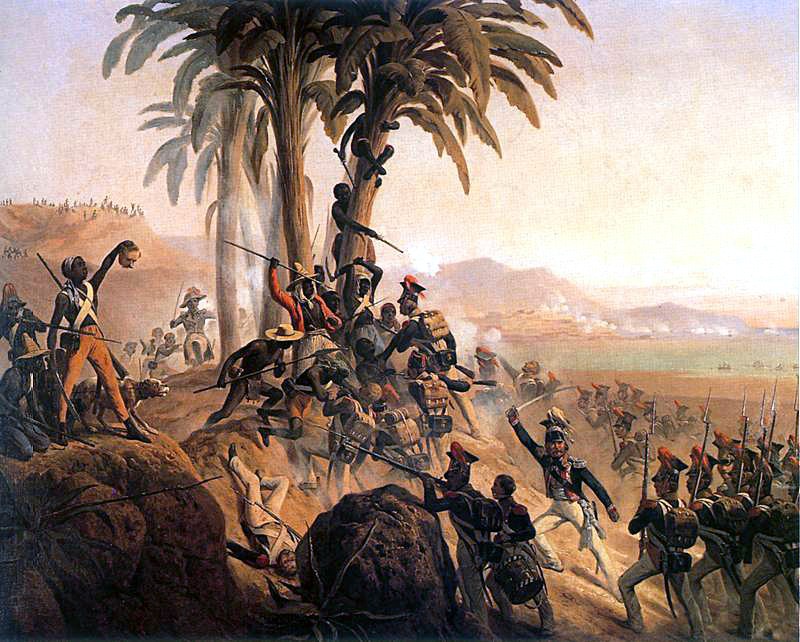 Battle for Santo Domingo, by January Suchodolski (1845) 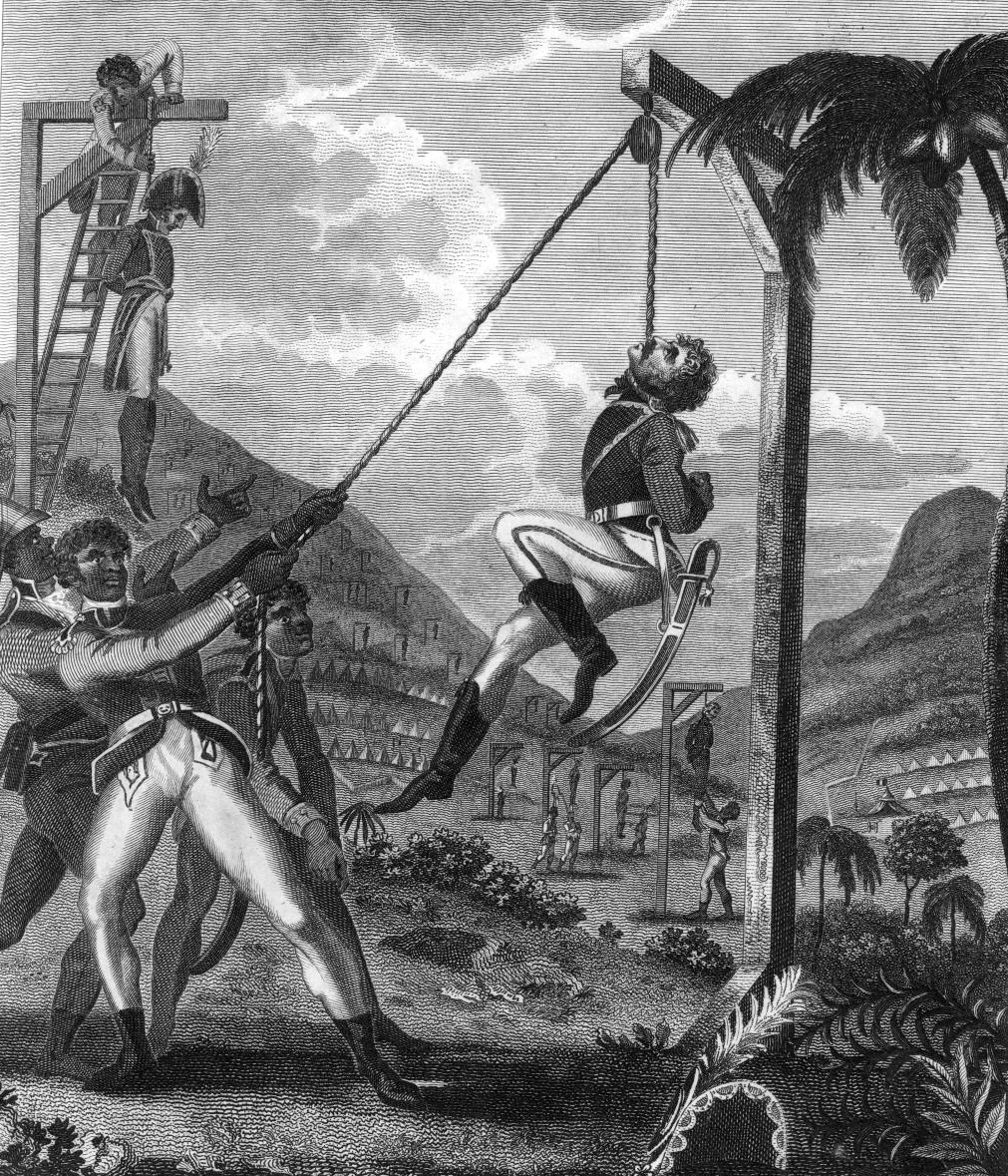 "The Mode of exterminating the Black Army, as practiced by the French", by Marcus Rainsford, 1805  "Revenge taken by the Black Army for the Cruelties practiced on them by the French", by Marcus Rainsford, 1805 Toussaint, however, asserted so much independence that in 1802, Napoleon sent a massive invasion force, under his brother-in-law Charles Leclerc, to increase French control. For a time, Leclerc met with some success; he also brought the eastern part of the island of Hispaniola under the direct control of France in accordance with the terms of the 1795 Treaties of Bâle with Spain. With a large expedition that eventually included 40,000 European troops, and receiving help from white colonists and mulatto forces commanded by Alexandre Pétion, a former lieutenant of Rigaud, the French won several victories after severe fighting. Two of Toussaint's chief lieutenants, Dessalines and Christophe, recognizing their untenable situation, held separate parleys with the invaders and agreed to transfer their allegiance. At this point, Leclerc invited Toussaint to negotiate a settlement. It was a deception; Toussaint was seized and deported to France, where he died in April 1803 of pneumonia, while imprisoned at Fort de Joux in the Jura Mountains. On 20 May 1802, Napoleon signed a law to maintain slavery where it had not yet disappeared, namely Martinique, Tobago, and Saint Lucia. A confidential copy of this decree was sent to Leclerc, who was authorized by Napoleon to restore slavery in Saint-Domingue when the time was opportune. At the same time, further edicts stripped the gens de couleur of their newly won civil rights. None of these decrees were published or executed in Saint-Domingue, but, by midsummer, word began to reach the colony of the French intention to restore slavery. The betrayal of Toussaint and news of French actions in Martinique undermined the collaboration of leaders such as Dessalines, Christophe, and Pétion. Convinced that the same fate lay in store for Saint-Domingue, these commanders and others once again battled Leclerc. As the French were intent on reconquest and re-enslavement of the colony's black population, the war became a bloody struggle of atrocity and attrition. The rainy season brought yellow fever and malaria, which took a heavy toll on the invaders. By November, when Leclerc died of yellow fever, 24,000 French soldiers were dead and 8,000 were hospitalized, the majority from disease.[36] Afterward, Leclerc was replaced by Donatien-Marie-Joseph de Vimeur, vicomte de Rochambeau. Rochambeau wrote to Napoleon that, to reclaim Saint-Domingue, France must "declare the negroes slaves, and destroy at least 30,000 negroes and negresses."[37] In his desperation, he turned to increasingly wanton acts of brutality; the French burned alive, hanged, drowned, and tortured black prisoners, reviving such practices as burying blacks in piles of insects and boiling them in cauldrons of molasses. One night, at Port-Républican, he held a ball to which he invited the most prominent mulatto ladies and, at midnight, announced the death of their husbands. However, each act of brutality was repaid by the Haitian rebels. After one battle, Rochambeau buried 500 prisoners alive; Dessalines responded by hanging 500 French prisoners.[38] Rochambeau's brutal tactics helped unite black and mulatto soldiers against the French. As the tide of the war turned toward the former slaves, Napoleon abandoned his dreams of restoring France's New World empire. In 1803, war resumed between France and Britain, and with the Royal Navy firmly in control of the seas, reinforcements and supplies for Rochambeau never arrived in sufficient numbers. To concentrate on the war in Europe, Napoleon signed the Louisiana Purchase in April, selling France's North American possessions to the United States. The Haitian army, now led by Dessalines, devastated Rochambeau and the French army at the Battle of Vertières on 18 November 1803. On 1 January 1804 Dessalines then declared independence,[39] reclaiming the indigenous Taíno name of Haiti ("Land of Mountains") for the new sovereign state. Most of the remaining French colonists fled ahead of the defeated French army, many migrating to Louisiana or Cuba. Unlike Toussaint, Dessalines showed little equanimity with regard to the whites. In a final act of retribution, the remaining French were slaughtered by Haitian military forces in a white genocide. Some 2,000 Frenchmen were massacred at Cap-Français, 900 in Port-au-Prince, and 400 at Jérémie. He issued a proclamation declaring, "we have repaid these cannibals, war for war, crime for crime, outrage for outrage."[40] One exception to Dessalines' proclamation was a group of Poles from the Polish Legions that had joined the French military under Napoleon.[41] A majority of Polish soldiers refused to fight against the Haitian forces. At the time, there was a familiar situation going on back in their homeland, as these Polish soldiers were fighting for their liberty from the invading Russians, Prussians and Austrians that began in 1772. As hopeful as the Haitians, many Poles were seeking union amongst themselves to win back their homeland. As a result, many Polish soldiers admired their enemy and decided to turn on the French army and join the Haitian former slaves, and participated in the Haitian revolution of 1804, supporting the principles of liberty for all the people. Władysław Franciszek Jabłonowski, who was half Black, was one of the Polish generals at the time. Polish soldiers had a remarkable input in helping the Haitians in their retaliation against the French oppressor. They were spared the fate of other Europeans. For their loyalty and support for overthrowing the French, some Poles acquired Haitian citizenship after Haiti gained its independence, and many of them settled there, never to return to Poland. It is estimated that around 500 of the 5,280 Poles chose this option. Of the remainder, 700 returned to France to eventually return to Poland, and some, after capitulating, agreed to serve in the British Army.[41] 160 Poles were later given permission to leave Haiti and some were sent to France at Haitian expense. To this day, many Polish Haitians still live in Haiti and are of multiracial descent; some have blonde hair, light eyes, and other European features. Today, descendants of those Poles who stayed are living in Cazale, Fond-des-Blancs, La Vallée-de-Jacmel, La Baleine, Port-Salut and Saint-Jean-du-Sud.[41] Following Haitian independence, the new independent state struggled economically, as European countries and the United States refused to extend diplomatic recognition to Haiti. In 1825, the French returned with a fleet of fourteen warships and demanded an indemnity of 150 million francs in exchange for diplomatic recognition; Haitian President Jean-Pierre Boyer agreed to the French demands under duress. In order to finance the debt, the Haitian government was forced to take numerous high-interest loans from foreign creditors, and the debt to France was not fully paid until 1947.[42][43][44] |
ナポレオン敗北(1802-1804) 主な記事 サン・ドマング遠征  キャップ・フランセに上陸したルクレール率いるフランス軍(1802年)  ルクレール率いる退役軍人がラヴィーヌ・ア・クルーヴル(蛇の渓谷)を襲撃する(1802年  サント・ドミンゴの戦い、1月スチョドルスキー作(1845年) 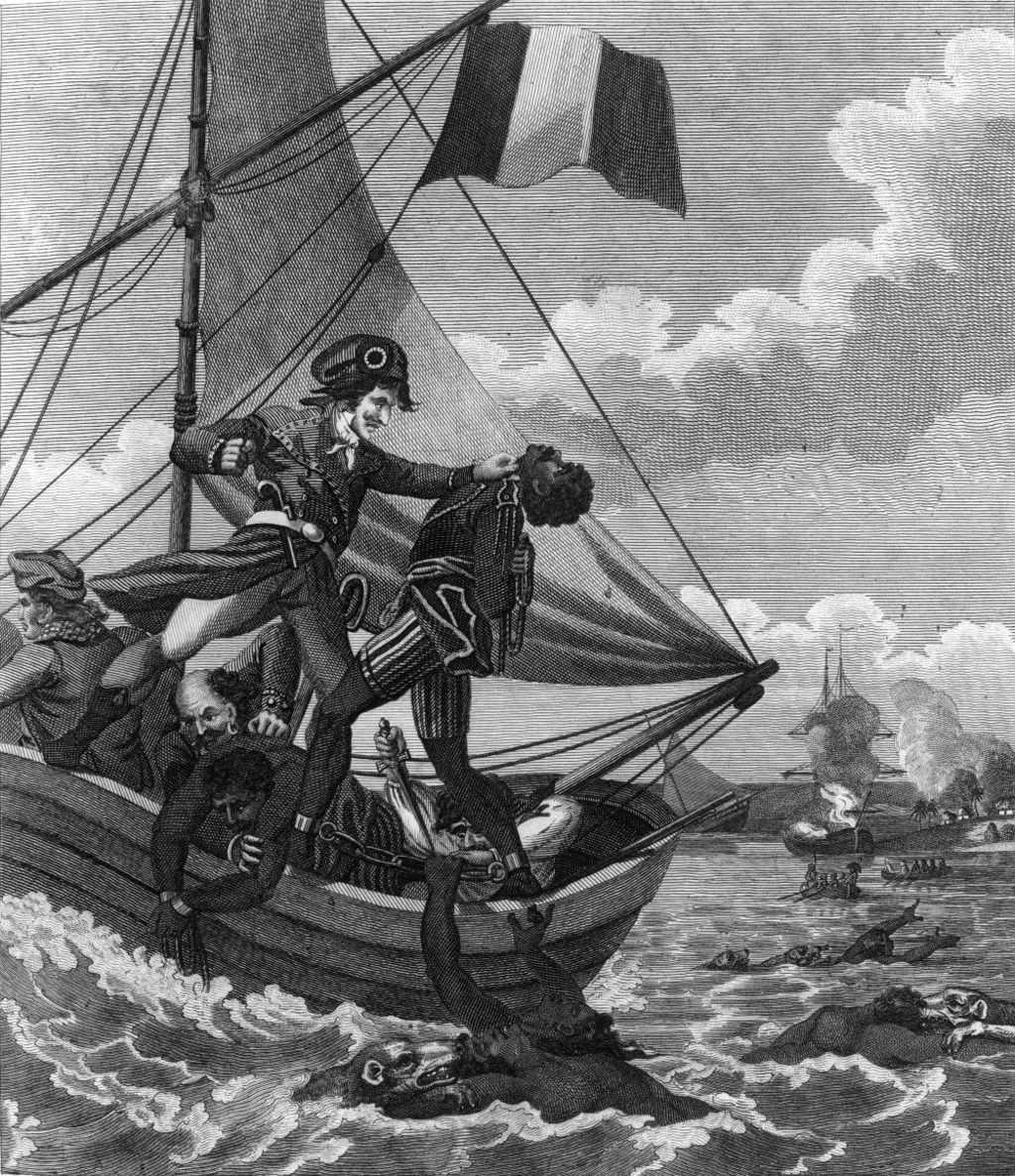 マーカス・レインズフォード著「フランス軍が実践した黒人軍退治の方法」1805年  「フランス人による残虐行為に対して黒人軍がとった復讐」マーカス・レインズフォード著1805年 1802年、ナポレオンは義弟シャルル・ルクレール率いる大規模な侵攻軍を送り込み、フランスの支配を強めた。ルクレールは1795年のスペインとのバー ル条約に基づき、イスパニョーラ島東部をフランスの直接統治下に置いた。最終的には4万人のヨーロッパ軍を含む大遠征を行い、リゴーの元中尉であったアレ クサンドル・ペシオンが指揮する白人入植者と混血部隊の支援を受け、フランス軍は激しい戦闘の末にいくつかの勝利を収めた。トゥーサンの2人の副官、デッ サリーヌとクリストフは、自分たちの不利な状況を認識し、侵略者と個別に交渉し、忠誠を移すことに同意した。この時点で、ルクレールはトゥーサンに和解交 渉を持ちかけた。トゥーサンは捕らえられてフランスに追放され、ジュラ山脈のジュウ砦に幽閉されていた1803年4月に肺炎で死亡した。 1802年5月20日、ナポレオンはマルティニーク、トバゴ、セントルシアというまだ奴隷制度が消滅していない地域で奴隷制度を維持する法律に署名した。 この勅令の機密コピーはルクレールに送られ、ルクレールはナポレオンから、時期が来たらサン=ドマングに奴隷制を復活させる権限を与えられた。同時に、さ らなる勅令が、新たに獲得した市民権を、青年の人々から剥奪した。これらの勅令はいずれもサン=ドマングでは公布も執行もされなかったが、真夏になると、 フランスが奴隷制を復活させる意図であることが植民地に伝わり始めた。トゥーサンの裏切りやマルティニークでのフランスの行動の知らせは、デサリンヌ、ク リストフ、ペシオンといった指導者たちの協力体制を蝕んだ。サン=ドマングにも同じ運命が待ち受けていると確信したこれらの指揮官らは、再びルクレールと 戦った。フランス軍は植民地の黒人のレコンキスタ(再征服)と再奴隷化を意図していたため、戦争は残虐行為と消耗による血みどろの戦いとなった。雨季には 黄熱病とマラリアが流行し、侵略者たちは大打撃を受けた。ルクレールが黄熱病で死亡した11月までに、24,000人のフランス兵が死亡し、8,000人 が入院したが、その大半は病気によるものであった[36]。 その後、ルクレールの後任としてロシャンボー総督ドナティアン=マリー=ジョゼフ・ド・ヴィムールが任命された。ロシャンボーはナポレオンに、サン・ドマ ングを取り戻すためには、フランスは「黒人を奴隷と宣言し、少なくとも3万人の黒人と黒人を滅ぼさなければならない」と書き送った[37]。ある夜、彼は ポルト・レピュブリカンで舞踏会を開き、最も著名な混血の女性たちを招待し、真夜中に彼女たちの夫の死を宣言した。しかし、その残忍な行為のひとつひとつ がハイチの反乱軍に返り討ちにされた。ある戦いの後、ロシャンボーは500人の捕虜を生き埋めにし、デサリネスはそれに応えて500人のフランス人捕虜を 絞首刑にした[38]。ロシャンボーの残忍な戦術は、黒人と混血の兵士をフランス軍に対して団結させるのに役立った。 戦争の流れが元奴隷たちに傾くと、ナポレオンはフランスの新世界帝国復活の夢を捨てた。1803年、フランスとイギリスの間で戦争が再開され、イギリス海 軍が制海権を握っていたため、ロシャンボーへの援軍や物資が十分な数届くことはなかった。ヨーロッパでの戦争に集中するため、ナポレオンは4月にルイジア ナ購入に調印し、フランスの北米領土をアメリカに売却した。デッサリーヌ率いるハイチ軍は、1803年11月18日のヴェルティエールの戦いでロシャン ボーとフランス軍を壊滅させた。 1804年1月1日、デサリーヌは独立を宣言し[39]、ハイチという先住民のタイノ語(「山の国」)を新たな主権国家として復活させた。残されたフラン ス人入植者のほとんどは、敗走するフランス軍に先んじて逃亡し、その多くはルイジアナやキューバに移住した。トゥーサンとは異なり、デッサリーヌは白人に 対して冷静さを欠いた。最後の報復として、残ったフランス人はハイチ軍によって虐殺された。約2000人のフランス人がキャップ・フランセで、900人が ポルトープランスで、400人がジェレミーで虐殺された。デサリーヌは「戦争には戦争を、犯罪には犯罪を、暴挙には暴挙を、我々はこの人食い人種に報復し た」と宣言した[40]。 デサリーヌの布告に対する一つの例外は、ナポレオン政権下でフランス軍に参加していたポーランド軍団のポーランド人グループであった[41]。 ポーランド兵の大多数はハイチ軍との戦闘を拒否した。当時、彼らの祖国では、1772年に始まったロシア、プロイセン、オーストリアの侵攻から自分たちの 自由を守るためにポーランド兵たちが戦っているという、見慣れた状況が進行していた。ハイチ人と同じように、多くのポーランド人が祖国を取り戻すため、自 分たちの間で団結を模索していた。その結果、多くのポーランド兵が敵に憧れ、フランス軍に反旗を翻してハイチの元奴隷に加わることを決意し、1804年の ハイチ革命に参加し、全人民の自由の原則を支持した。黒人とのハーフであったヴワディスワフ・フランシシェク・ヤブウォノフスキは、当時のポーランド軍将 兵の一人であった。ポーランドの兵士たちは、フランスの圧制者に対する報復においてハイチ人を助けるという目覚ましい働きをした。彼らは他のヨーロッパ人 の運命を免れた。フランス打倒への忠誠と支援のため、ハイチが独立した後、何人かのポーランド人はハイチの市民権を取得し、彼らの多くはそこに定住し、 ポーランドに戻ることはなかった。5,280人のポーランド人のうち、約500人がこの選択肢を選んだと推定されている。残りのうち700人はフランスに 戻り、最終的にポーランドに戻ることになり、何人かは降伏後、イギリス軍への従軍に同意した[41]。後に160人のポーランド人にハイチからの出国許可 が与えられ、何人かはハイチの費用でフランスに送られた。今日に至るまで、多くのポーランド系ハイチ人がハイチに住んでおり、多民族系であり、金髪、明る い目、その他のヨーロッパ系の特徴を持つ者もいる。今日、滞在したポーランド人の子孫は、カザール、フォン=デ=ブラン、ラ・ヴァレ=ド=ジャクメル、 ラ・バレーヌ、ポルト=サルト、サン=ジャン=デュ=スードに住んでいる[41]。 ハイチの独立後、ヨーロッパ諸国とアメリカがハイチへの外交的承認を拒否したため、新しい独立国家は経済的に苦戦した。1825年、フランスは14隻の軍 艦を率いて帰還し、外交的承認と引き換えに1億5,000万フランの賠償を要求した。ハイチ大統領ジャン=ピエール・ボワイエは、強要されてフランスの要 求に同意した。債務を調達するためにハイチ政府は外国の債権者から高利の融資を何度も受けることを余儀なくされ、フランスへの債務は1947年まで完済さ れなかった[42][43][44]。 |
| Independence: The early years (1804–1843) Main article: Independence of Haiti 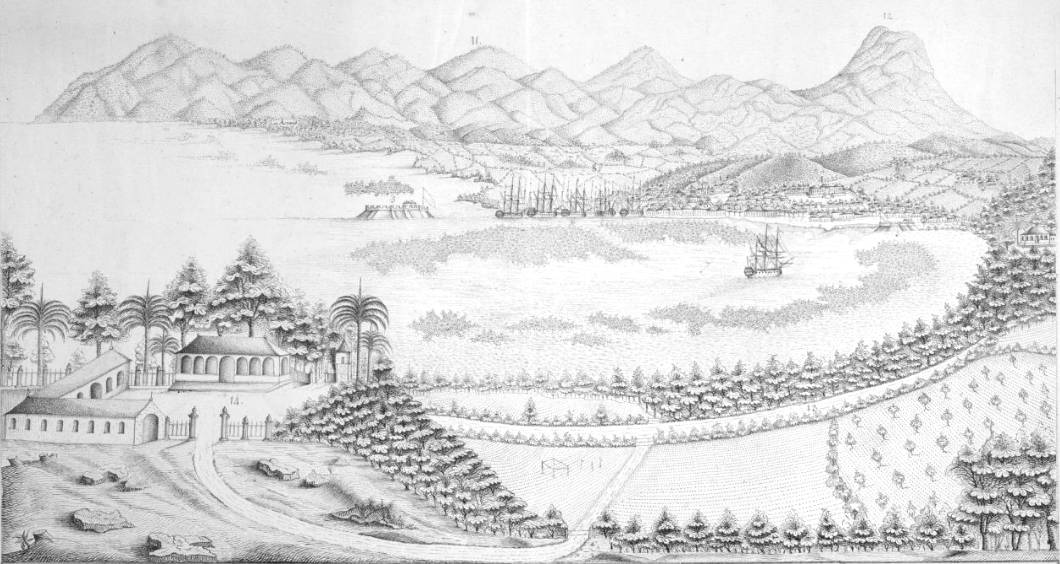 Port-au-Prince and surroundings at the start of the 19th century 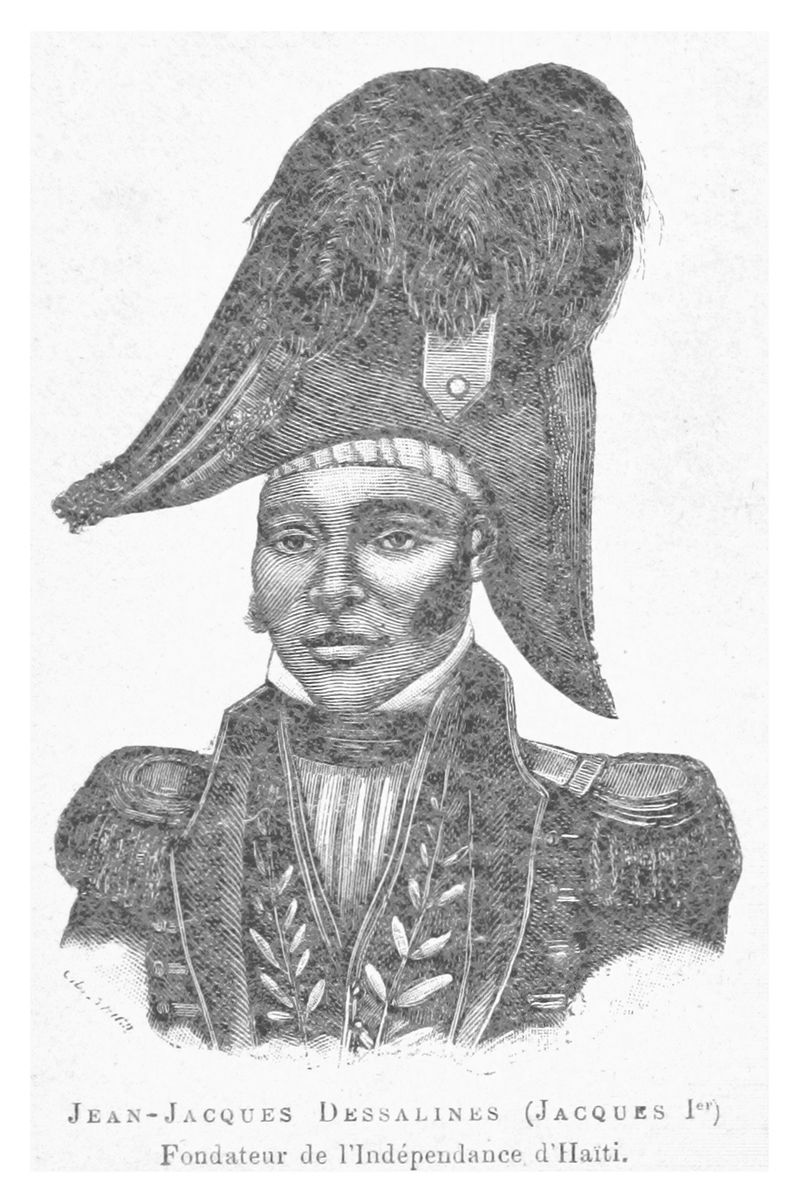 Jean-Jacques Dessalines Black Republic (1804) Haiti became the second independent state in the Western Hemisphere after the United States.[45] Haiti actively assisted the independence movements of many Latin American countries – and secured a promise from the great liberator, Simón Bolívar, that he would free slaves after winning independence from Spain. The country inhabitated mostly by former slaves remained excluded from the hemisphere's first regional meeting of independent states, held in Panama in 1826, largely due to the atrocities of the 1804 Haitian Genocide which targeted European men, women and children who resided in Haiti, including those who were favorable to the revolution.[46] Despite the efforts of anti-slavery senator Charles Sumner of Massachusetts, the United States did not recognize the independence of Haiti until 1862. The Southern slave states held a majority in Congress and, afraid of encouraging slave revolts, blocked this; Haiti was quickly recognized (along with other progressive measures, such as ending slavery in the District of Columbia), after these legislators left Washington in 1861, their states having declared their secession. Upon assuming power, General Dessalines authorized the Constitution of 1804. This constitution, in terms of social freedoms, called for: Freedom of religion. (Under Toussaint, Catholicism had been declared the official state religion.) All citizens of Haiti, regardless of skin color, to be known as "Black" (this was an attempt to eliminate the multi-tiered racial hierarchy that had developed in Haiti, with full or near full-blooded Europeans at the top, various levels of light to brown skin in the middle, and dark skinned "Kongo" from Africa at the bottom). White men were forbidden from possessing property or land on Haitian soil. Should the French return to reimpose slavery, Article 5 of the constitution declared: "At the first shot of the warning gun, the towns shall be destroyed and the nation will rise in arms."[47] |
独立 初期 (1804-1843) 主な記事 ハイチの独立  19世紀初頭のポルトープランスとその周辺  ジャン=ジャック・デサリネス 黒人共和国(1804年) ハイチは、西半球ではアメリカに次いで2番目の独立国となった[45]。ハイチは、ラテンアメリカ諸国の独立運動を積極的に支援し、偉大な解放者シモン・ ボリーバルから、スペインからの独立後に奴隷を解放するという約束を取り付けた。元奴隷が大半を占めるこの国は、1826年にパナマで開催された半球初の 地域独立国家会議から除外されたままであった。その主な理由は、1804年にハイチのジェノサイドが、革命に好意的だった人々を含む、ハイチ在住のヨー ロッパ人男性、女性、子供を標的にした残虐行為であったからである[46]。マサチューセッツ州の反奴隷制上院議員チャールズ・サムナーの努力にもかかわ らず、アメリカは1862年までハイチの独立を承認しなかった。南部の奴隷州が議会で多数を占めていたため、奴隷の反乱を助長することを恐れてこれを阻止 したのである。1861年にこれらの議員がワシントンを去り、各州が分離独立を宣言した後、ハイチは(コロンビア特別区の奴隷制廃止などの他の進歩的な措 置とともに)すぐに承認された。 デサリーヌ将軍は、政権に就くと1804年憲法を公布した。この憲法は、社会的自由の観点から、次のことを求めていた: 宗教の自由。(トゥーサンの時代には、カトリックが公式の国教とされていた)。 肌の色に関係なく、すべてのハイチ国民を「黒人」と呼ぶ(これは、完全な、あるいはそれに近いヨーロッパ人を頂点とし、中間に様々なレベルの明るい肌から 褐色の肌、そして最下層にアフリカから来た浅黒い肌の「コンゴ人」という、ハイチで発達した多層的な人種階層を排除しようとする試みであった)。 白人はハイチの土地で財産や土地を所有することを禁じられた。フランスが奴隷制を復活させるために戻ってきた場合、憲法第5条はこう宣言した: 「最初の威嚇射撃で町は破壊され、国民は武装して立ち上がる」[47]。 |
| First Haitian Empire (1804–1806) Main article: First Empire of Haiti On 1 January 1804, Dessalines proclaimed Haiti an independent sovereign state.[48] Mid-February, Dessalines told some cities (Léogâne, Jacmel, Les Cayes) to prepare for mass massacres.[49] On 22 February 1804, he signed a decree ordering that all whites in all cities should be put to death.[50] The weapons used should be silent weapons such as knives and bayonets rather than gunfire, so that the killing could be done more quietly, and avoid warning intended victims by the sound of gunfire and thereby giving them the opportunity to escape.[51] On 22 September 1804, Dessalines proclaimed himself Emperor Jacques I. Yet two of his own advisers, Henri Christophe and Alexandre Pétion, helped bring about his assassination in 1806. The conspirators ambushed him north of Port-au-Prince at Pont Larnage (now known as Pont-Rouge) on 17 October 1806 en route to battle rebels to his regime. The state created under Dessalines was the opposite of what the Haitian lower class wanted. While both the elite leaders, such as Dessalines, and the Haitian population agreed the state should be built on the ideals of freedom and democracy,[52][53] these ideals in practice looked very different for the two groups. The main reason for this difference in viewpoints of nationalisms come from the fact that one group lived as slaves, and the other did not.[when?][54] For one, the economic and agricultural practices of Dessalines, and leaders after him, were based on the need to create a strong economic state, that was capable of maintaining a strong military.[55] For the elite leaders of Haiti, maintaining a strong military to ward off either the French or other colonial powers and ensure independence would secure a free state. The leaders of Haiti saw independence from other powers as their notion of freedom. However, the Haitian peasantry tied their notion of freedom to the land. Because of the mountainous terrain, Haitian slaves were able to cultivate their own small tracts of land. Thus, freedom for them was the ability to cultivate their own land within a subsistence economy. Unfortunately, because of the leaders' desires, a system of coerced plantation agriculture emerged.[56] Furthermore, while all Haitians desired a black republic,[53] the cultural practices of African Americans were a point of contention. Many within the Haitian population wanted to maintain their African heritage, which they saw as a logical part of the black republic they wanted. However, the elites typically tried to prove the sophistication of Haitians through literature. Some authors wrote that the barbarism of Africa must be expelled, while maintaining African roots.[57] Furthermore, other authors tried to prove the civility of the elite Haitians by arguing that Blacks were capable of establishing and running a government by changing and augmenting the history of the revolution to favor the mulatto and black elites, rather than the bands of slaves.[58] Furthermore, to maintain freedom and independence, the elites failed to provide the civil society that the Haitian mass desired. The Haitian peasants desired not only land freedom but also civil rights, such as voting and political participation, as well as access to education.[54] The state failed to provide those basic rights. The state was essentially run by the military, which meant that it was very difficult for the Haitian population to participate in any democratic process. Most importantly, the state failed to provide the access to education that a state of former slaves needed.[59] It was nearly impossible for the former slaves to participate effectively because they lacked the basic literacy that had been intentionally denied to them under French colonial rule. Through their differing views on Haitian nationalism and freedom, the elites created a state that greatly favored them, instead of the Haitian peasantry. |
第一ハイチ帝国 (1804-1806) 主な記事 ハイチ第一帝国 1804年1月1日、デッサリーヌはハイチの独立を宣言した[48]。2月中旬、デッサリーヌはいくつかの都市(レオガン、ジャクメル、レ・ケイス)に対 し、大量虐殺の準備をするよう指示した[49]。1804年2月22日、デッサリーヌはすべての都市のすべての白人を死刑にするよう命じる法令に署名し た。 [50]使用される武器は銃声ではなく、ナイフや銃剣のような沈黙の武器であるべきであり、殺戮がより静かに行われ、銃声によって意図した犠牲者を警告 し、それによって彼らに逃げる機会を与えることを避けるためであった[51]。 1804年9月22日、デッサリーヌは自らを皇帝ジャック1世と宣言したが、1806年、アンリ・クリストフとアレクサンドル・ペシオンの2人の助言者が デッサリーヌの暗殺に協力した。陰謀家たちは1806年10月17日、ポルトープランスの北、ポン・ラルナージュ(現在のポン・ルージュ)で彼を待ち伏せ し、政権への反乱軍と戦わせた。 デサリーヌの下で誕生した国家は、ハイチの下層階級が望んでいたものとは正反対のものだった。デサリーヌのようなエリート指導者もハイチ国民も、国家が自 由と民主主義の理想に基づいて建設されるべきであるという点では同意していたが[52][53]、実際にはこれらの理想は2つのグループにとって非常に異 なるものであった。このようなナショナリズムの視点の差の主な理由は、一方の集団が奴隷として生活し、他方の集団は奴隷として生活していなかったことに由 来する[when?][54]。1つには、デサリネスや彼以降の指導者たちの経済的・農業的実践は、強力な軍隊を維持することができる強力な経済国家を創 設する必要性に基づいていた[55]。ハイチのエリート指導者たちにとっては、フランスや他の植民地勢力を追い払い、独立を確保するために強力な軍隊を維 持することが自由な国家を確保することになった。ハイチの指導者たちは、他の列強からの独立を自分たちの考える自由とみなしていた。 しかし、ハイチの農民たちは、自由という概念を土地に結びつけていた。山がちな地形のため、ハイチの奴隷たちは自分たちの小さな土地を耕すことができた。 したがって、彼らにとっての自由とは、自給自足経済の中で自分の土地を耕す能力だった。残念なことに、指導者たちの欲望のために、強制的なプランテーショ ン農業のシステムが出現した[56]。さらに、ハイチ人全員が黒人共和国を望んでいた一方で[53]、アフリカ系アメリカ人の文化的慣習が争点となった。 ハイチ国民の多くはアフリカの伝統を維持することを望み、それは彼らが望む黒人共和国の論理的な一部であると考えた。しかし、エリートたちは通常、文学を 通じてハイチ人の洗練性を証明しようとした。アフリカのルーツを維持しつつ、アフリカの野蛮さを追放しなければならないと書いた作家もいた[57]。 さらに他の著者は、奴隷の一団よりもむしろ混血や黒人のエリートに有利になるように革命の歴史を変更し補強することによって、黒人は政府を樹立し運営する 能力があると主張することによって、ハイチのエリートたちの礼節を証明しようとした[58]。さらに、自由と独立を維持するために、エリートたちはハイチ の大衆が望む市民社会を提供することができなかった。ハイチの農民は土地の自由だけでなく、選挙権や政治参加、教育へのアクセスといった市民権も望んでい た[54]。 国家は基本的に軍によって運営されていたため、ハイチの人々が民主的なプロセスに参加することは非常に困難だった。最も重要なことは、国家が元奴隷の国家 が必要としていた教育へのアクセスを提供できなかったことである。フランスの植民地支配下で意図的に否定されていた基本的な識字能力を欠いていたため、元 奴隷が効果的に参加することはほぼ不可能だった[59]。ハイチのナショナリズムと自由に対する異なる見解を通じて、エリートたちはハイチの農民の代わり に自分たちを大いに優遇する国家を作り上げた。 |
The struggle for unity (1806–1820)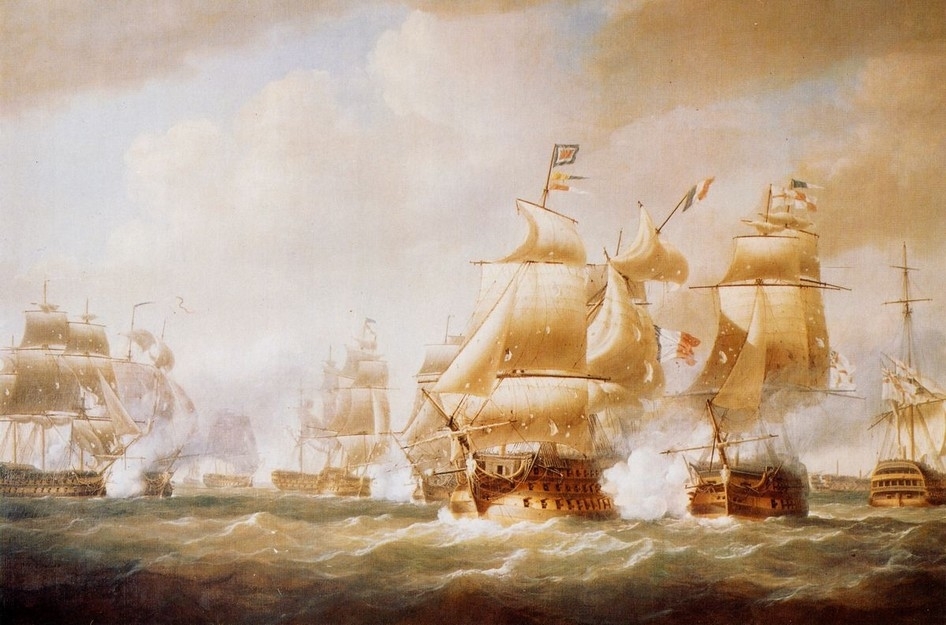 The battle of Santo Domingo (1806) painted by Nicholas Pocock in 1808 After the Dessalines coup d'état, the two main conspirators divided the country in two rival regimes. Christophe created the authoritarian State of Haiti in the north, and the gens de couleur Pétion established the Republic of Haiti in the south. Christophe attempted to maintain a strict system of labor and agricultural production akin to the former plantations. Although, strictly speaking, he did not establish slavery, he imposed a semi-feudal system, fumage, in which every able man was required to work in plantations (similar to Spanish latifundios) to produce goods for the fledgling country. His method, though undoubtedly oppressive, produced the greater revenues of the two governments. In contrast, Pétion broke up the former colonial estates and parceled out the land into small holdings. In Pétion's south, the gens de couleur minority led the government and feared losing popular support, and thus, they reduced class tensions by land redistribution. Because of the weak international position and its labor policies (most peasants lived through a subsistence economy), Pétion's government was perpetually on the brink of bankruptcy. Yet, for most of its time, it produced one of the most liberal and tolerant Haitian governments ever. In 1815, at a key period of Bolívar's fight for Venezuelan independence, Pétion gave the Venezuelan leader asylum and provided him soldiers and substantial material support. Pétion also had the fewest internal military skirmishes, despite his continuous conflicts with Christophe's northern kingdom. In 1816, however, after finding the burden of the Senate intolerable,[further explanation needed] he suspended the legislature and turned his post into President for Life. Not long after, he died of yellow fever, and his assistant Jean-Pierre Boyer replaced him. 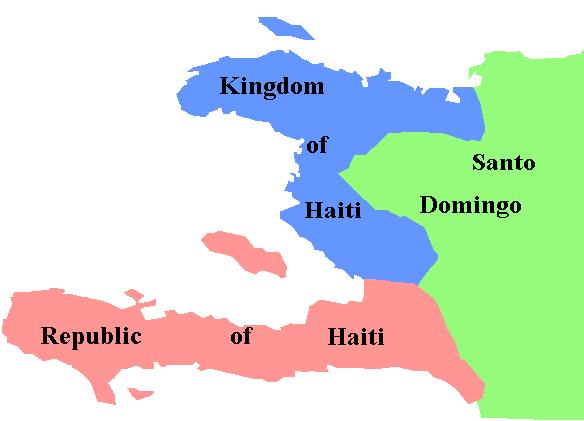 The Kingdom of Haiti in the North and the Republic of Haiti in the South In this period, the eastern part of the island rose against the new powers, following general Juan Sánchez Ramírez's claims of independence from France, which broke the Treaties of Bâle attacking Spain[further explanation needed] and prohibited commerce with Haiti. In the Palo Hincado battle (7 November 1808), all the remaining French forces were defeated by Spanish-creole insurrectionists. On 9 July 1809, the Spanish colony Santo Domingo was born. The government put itself under the control of Spain, earning it the nickname of "España Boba" (meaning "The Idiot Spain"). In 1811, Henri Christophe proclaimed himself King Henri I of the Kingdom of Haiti in the North and commissioned several extraordinary buildings. He even created a nobility class in the fashion of European monarchies. Yet in 1820, weakened by illness and with decreasing support for his authoritarian regime, he killed himself with a silver bullet rather than face a coup d'état. Immediately after, Pétion's successor, Boyer, reunited Haiti through diplomatic tactics and ruled as president until his overthrow in 1843. |
統一への闘い(1806年-1820年) 1808年にニコラス・ポコックが描いたサント・ドミンゴの戦い(1806年 デサリンヌのクーデター後、2人の主謀者は国を2つの対立する政権に分割した。クリストフは北部に権威主義的なハイチ国家を、ペシオンは南部にハイチ共和 国を樹立した。クリストフは、かつてのプランテーションのような厳格な労働・農業生産システムを維持しようとした。厳密には奴隷制度は設けなかったが、半 封建的な制度であるフマージュを課し、能力のある者はすべてプランテーション(スペインのラティフンディオに類似)で働き、新興国のために商品を生産する ことを義務づけた。彼の方法は、間違いなく抑圧的ではあったが、2つの政府の中でより大きな収入をもたらした。 対照的に、ペシオンは旧植民地領地を分割し、土地を小区画化した。ペティオンの南部では、少数派であるジェン・ド・クルールが政府を率いており、民衆の支 持を失うことを恐れていたため、土地の再分配によって階級間の緊張を緩和した。国際的な立場が弱く、労働政策(大半の農民は自給自足経済で生活していた) により、ペシオン政権は常に破綻の危機に瀕していた。しかし、そのほとんどの期間、ハイチ史上最も自由で寛容な政府を生み出した。1815年、ボリーバル がベネズエラ独立のために戦っていた重要な時期に、ペシオンはベネズエラの指導者を亡命させ、兵士と実質的な物質的支援を与えた。ペティオンはまた、クリ ストフの北方王国と絶えず対立していたにもかかわらず、軍事的小競り合いも最も少なかった。しかし1816年、元老院の負担に耐えられなくなったペティオ ンは[さらに説明が必要]、元老院を一時停止し、終身大統領となった。ほどなくして彼は黄熱病で死去し、助手のジャン=ピエール・ボワイエが後任となっ た。  北部のハイチ王国と南部のハイチ共和国 この時期、フアン・サンチェス・ラミレス将軍がフランスからの独立を主張し、スペインを攻撃したバール条約[さらに説明が必要]を破棄してハイチとの通商 を禁止したため、島の東部は新勢力に反旗を翻した。パロ・ヒンカドの戦い(1808年11月7日)では、残存していたフランス軍すべてがスペイン系クレ オール人の反乱軍に敗北した。1809年7月9日、スペインの植民地サント・ドミンゴが誕生した。政府は自らをスペインの支配下に置き、「エスパーニャ・ ボバ」(「バカなスペイン」の意)というニックネームを得た。 1811年、アンリ・クリストフは北のハイチ王国の国王アンリ1世を宣言し、いくつかの素晴らしい建物を建設した。ヨーロッパの君主制にならって貴族階級 まで創設した。しかし1820年、病気で衰弱し、権威主義的な政権への支持も減っていた彼は、クーデターに直面することなく銀の弾丸で自殺した。その直 後、ペシオンの後継者ボワイエが外交戦術によってハイチを統一し、1843年に倒されるまで大統領として統治した。 |
| Boyer's domination of Hispaniola (1820–1843) Main article: Republic of Haiti (1820–1849) 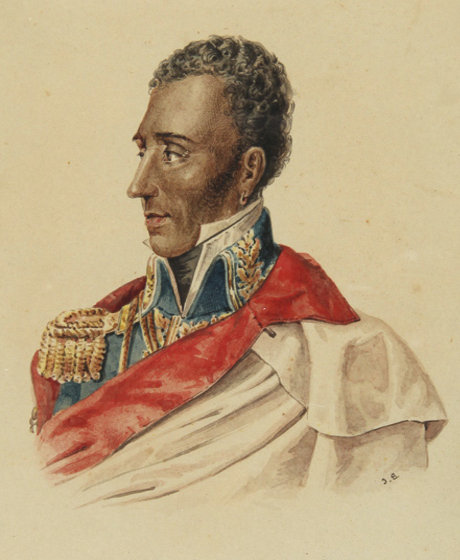 Jean-Pierre Boyer Almost two years after Boyer had consolidated power in the west, Haiti invaded Santo Domingo (present-day Dominican Republic) and declared the island free from European powers. Boyer, however, responding to a party on the east that preferred Haiti over Colombia, occupied the ex-Spanish colony in January 1822, encountering no military resistance. In this way he accomplished the unity of the island, which was only carried out for a short period of time by Toussaint Louverture in 1801. Boyer's occupation of the Spanish side also responded to internal struggles among Christophe's generals, to which Boyer gave extensive powers and lands in the east. This occupation, however, pitted the Spanish white elite against the iron fisted Haitian administration, and stimulated the emigration of many white wealthy families. The entire island remained under Haitian rule until 1844, when in the east a nationalist group called La Trinitaria led a revolt that partitioned the island into Haiti on the west and Dominican Republic on the east, based on what would appear to be a riverine territorial 'divide' from the pre-contact period. From 1824 to 1826, while the island was under one government, Boyer promoted the largest single free-Black immigration from the United States in which more than 6,000 immigrants settled in different parts of the island.[60] Today remnants of these immigrants live throughout the island, but the larger number reside in Samaná, a peninsula on the Dominican side of the island. From the government's perspective, the intention of the immigration was to help establish commercial and diplomatic relationships with the US, and to increase the number of skilled and agricultural workers in Haiti.[61] 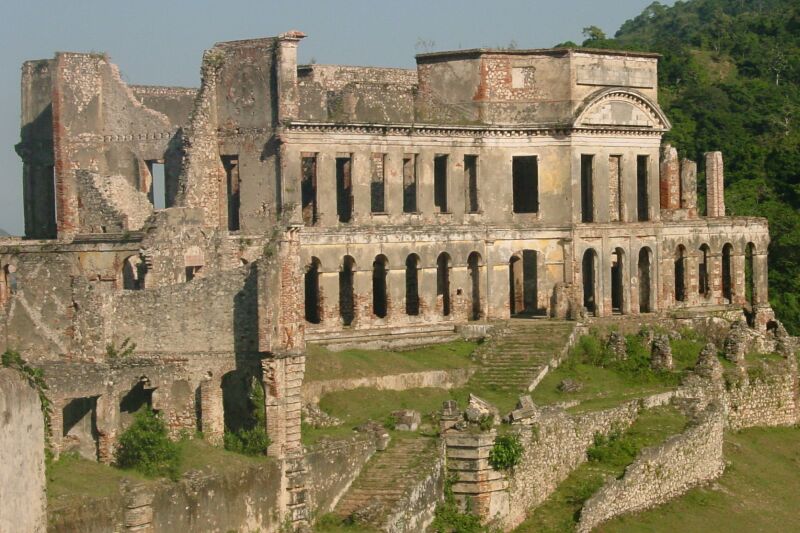 The ruins of the Sans-Souci Palace, severely damaged in the 1842 earthquake and never rebuilt In exchange for diplomatic recognition from France, Boyer was forced to pay a huge indemnity for the loss of French property during the revolution. To pay for this, he had to float loans in France, putting Haiti into a state of debt. Boyer attempted to enforce production through the Code Rural, enacted in 1826, but peasant freeholders, mostly former revolutionary soldiers, had no intention of returning to the forced labor they fought to escape. By 1840, Haiti had ceased to export sugar entirely, although large amounts continued to be grown for local consumption as taffia-a raw rum. However, Haiti continued to export coffee, which required little cultivation and grew semi-wild. The 1842 Cap-Haïtien earthquake destroyed the city, and the Sans-Souci Palace, killing 10,000 people. This was the third major earthquake to hit Western Hispaniola following the 1751 and 1770 Port-au-Prince earthquakes, and the last until the devastating earthquake of 2010. |
ボワイエによるイスパニョーラ支配(1820年-1843年) 主な記事 ハイチ共和国(1820年-1849年)  ジャン=ピエール・ボワイエ ボワイエが西方で権力を固めてから約2年後、ハイチはサント・ドミンゴ(現在のドミニカ共和国)に侵攻し、ヨーロッパ列強からの解放を宣言した。しかし、 ボワイエは、コロンビアよりもハイチを優先する東側の一派に呼応し、1822年1月に旧スペイン植民地を占領したが、軍事的抵抗はなかった。こうしてボワ イエは、1801年にトゥーサン・ルーヴェルチュールが短期間実行したに過ぎなかった島の統一を成し遂げた。ボワイエによるスペイン側の占領は、クリスト フの将軍たちの内部抗争にも呼応し、ボワイエは東部の広大な権限と土地を与えた。しかしこの占領は、スペインの白人エリート層と鉄拳制裁を加えるハイチ政 権を対立させ、多くの白人富裕層の移住を促した。島全体は1844年までハイチの統治下にあったが、東部でラ・トリニタリアと呼ばれる民族主義者グループ が反乱を起こし、島を西のハイチと東のドミニカ共和国に分割した。 1824年から1826年にかけて、島が1つの政府の下にあった間に、ボワイエはアメリカからの単一で最大規模の自由黒人移民を推進し、6,000人以上 の移民が島の各地に定住した[60]。今日、これらの移民の残党は島全体に居住しているが、より多くの移民が島のドミニカ共和国側の半島であるサマナに居 住している。政府から見た移民の意図主義は、アメリカとの商業・外交関係の確立を助け、ハイチにおける熟練労働者や農業労働者の数を増やすことであった [61]。  1842年の地震で甚大な被害を受け、再建されなかったサンスーシ宮殿跡 フランスからの外交的承認と引き換えに、ボワイエは革命で失ったフランスの財産に対して巨額の賠償金を支払うことを余儀なくされた。その支払いのためにフ ランスで借金をし、ハイチは借金地獄に陥った。ボワイエは、1826年に制定された農村法典によって生産を強制しようとしたが、農民の自由所有者は、その ほとんどが元革命兵士であり、逃れるために戦った強制労働に戻る意図はなかった。1840年までにハイチは砂糖の輸出を完全に停止したが、タフィア(ラム 酒の原料)として大量に栽培され、地産地消を続けた。しかし、ハイチはコーヒーの輸出を続け、コーヒーはほとんど耕作を必要とせず、半野生化していた。 1842年のカプ・ハイティエン地震により、ハイチは都市とサンスーシ宮殿を破壊し、1万人が死亡した。これは1751年と1770年のポルトープランス地震に続く、イスパニョーラ西部を襲った3度目の大地震であり、2010年の壊滅的な地震まで続いた。 |
Political struggles (1843–1915)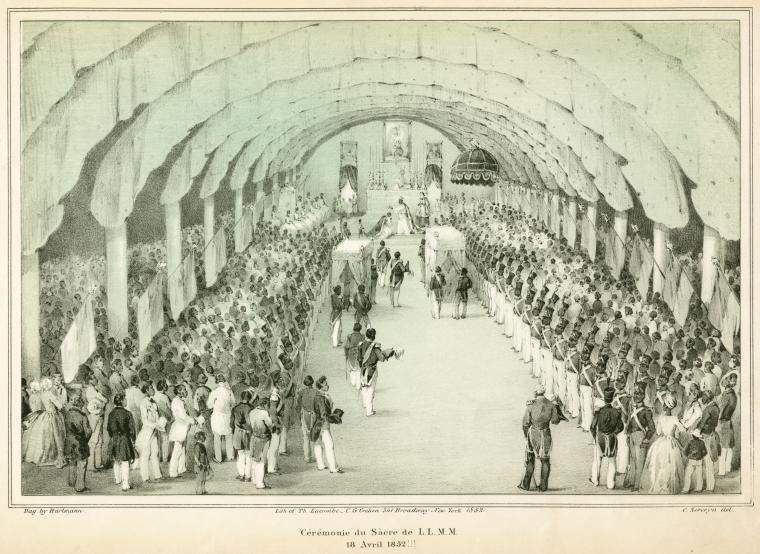 The coronation of Faustin I of Haiti in 1849 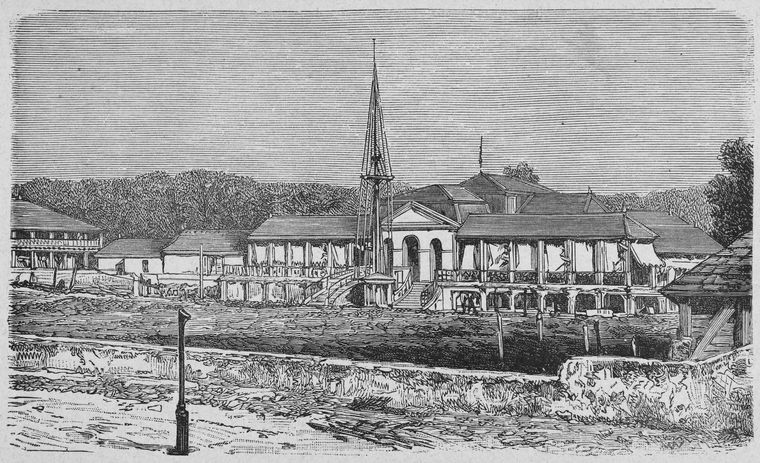 The National Palace burned down during the revolt against Salnave in 1868 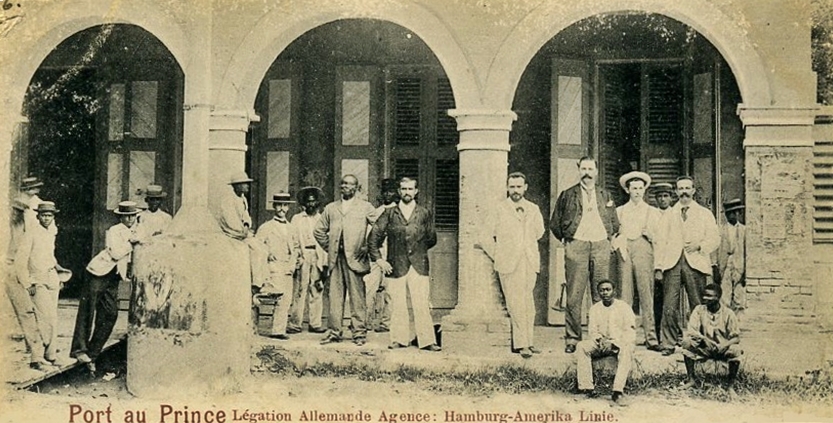 Staff of the German legation and the Hamburg-Amerika Line agency at Port-au-Prince, Haiti in 1900. The agency was involved in the staffing and management of the legation. German nationals were comparatively numerous in Haiti and heavily involved in the Haitian economy until World War I. 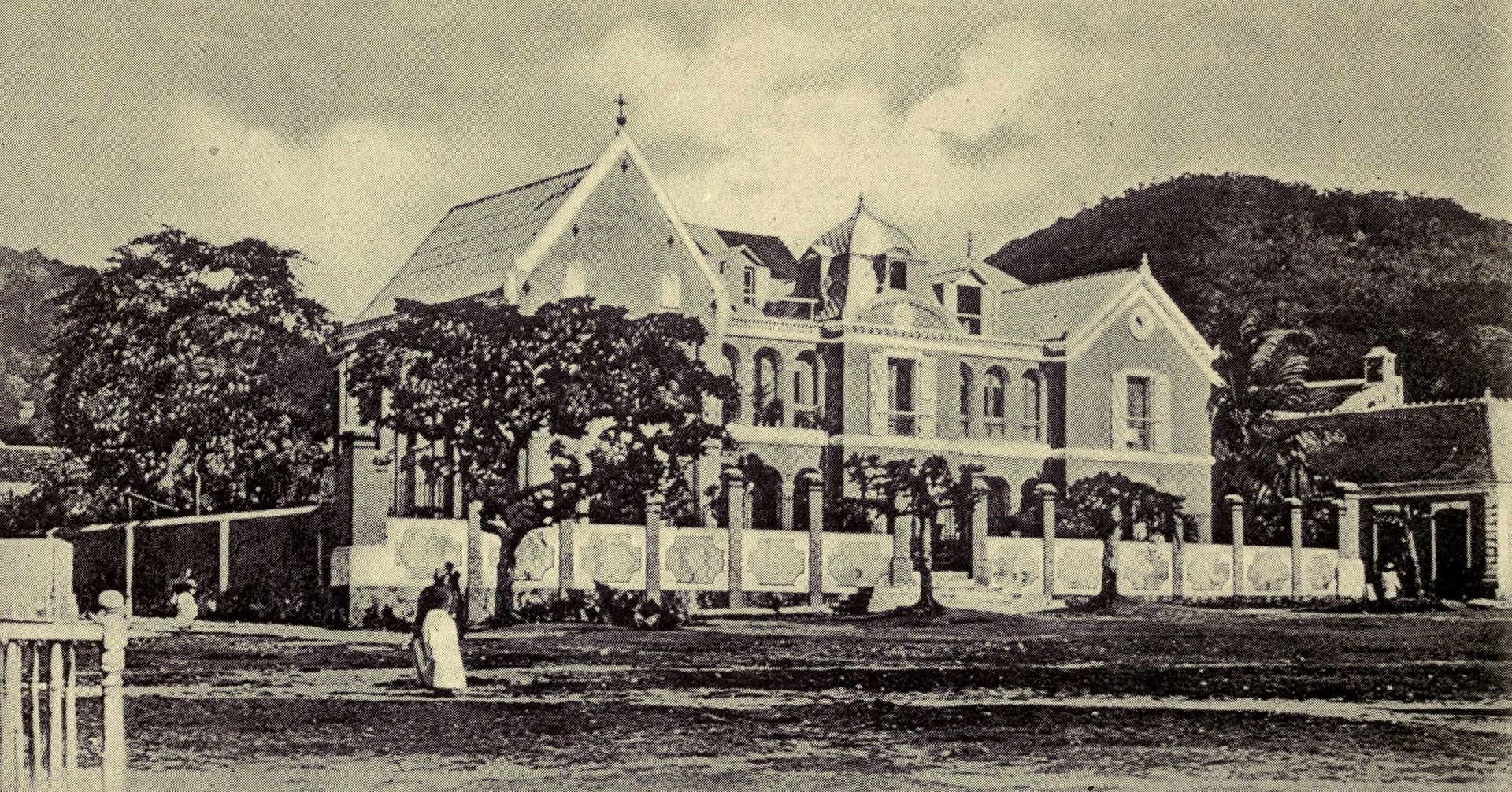 Bishop's House in Cap-Haitien, 1907 In 1843, a revolt, led by Charles Rivière-Hérard, overthrew Boyer and established a brief parliamentary rule under the Constitution of 1843. Revolts soon broke out and the country descended into near chaos, with a series of transient presidents until March 1847, when General Faustin Soulouque, a former slave who had fought in the rebellion of 1791, became president. During this period, Haiti unsuccessfully waged war against the Dominican Republic. In 1849, taking advantage of his popularity, President Faustin Soulouque proclaimed himself Emperor Faustin I. His iron rule succeeded in uniting Haiti for a time, but it came to an abrupt end in 1859 when he was deposed by General Fabre Geffrard, styled the Duke of Tabara. Geffrard's military government held office until 1867, and he encouraged a successful policy of national reconciliation. In 1860, he reached an agreement with the Vatican, reintroducing official Roman Catholic institutions, including schools, to the country. In 1867 an attempt was made to establish a constitutional government, but successive presidents Sylvain Salnave and Nissage Saget were overthrown in 1869 and 1874 respectively. A more workable constitution was introduced under Michel Domingue in 1874, leading to a long period of democratic peace and development for Haiti. The debt to France was finally repaid in 1879, and the government of President Pierre Théoma Boisrond-Canal peacefully transferred power to Lysius Salomon, one of Haiti's abler leaders. Monetary reform, with the creation in 1880-1881 of the National Bank of Haiti, and a cultural renaissance ensued with a flowering of Haitian art. The last two decades of the 19th century were also marked by the development of a Haitian intellectual culture. Major works of history were published in 1847 and 1865. Haitian intellectuals, led by Louis-Joseph Janvier and Anténor Firmin, engaged in a war of letters against a tide of racism and Social Darwinism that emerged during this period. The Constitution of 1867 saw peaceful and progressive transitions in government that did much to improve the economy and stability of the Haitian nation and the condition of its people. Constitutional government restored the faith of the Haitian people in legal institutions. The development of industrial sugar and rum industries near Port-au-Prince made Haiti, for a while, a model for economic growth in Latin American countries. This period of relative stability and prosperity ended in 1911, when revolution broke out and the country slid once again into disorder and debt. From 1911 to 1915, there were six different presidents, each of whom was killed or forced into exile.[62] The revolutionary armies were formed by cacos, peasant brigands from the mountains of the north, along the porous Dominican border, who were enlisted by rival political factions with promises of money to be paid after a successful revolution and an opportunity to plunder. The United States was particularly apprehensive about the role of the German community in Haiti (approximately 200 in 1910), who wielded a disproportionate amount of economic power. Germans controlled about 80% of the country's international commerce; they also owned and operated utilities in Cap Haïtien and Port-au-Prince, the main wharf and a tramway in the capital, and a railroad serving the Plaine de Cul-du-Sac. The German community proved more willing to integrate into Haitian society than any other group of white foreigners, including the French. A number married into the nation's most prominent mulatto families, bypassing the constitutional prohibition against foreign land-ownership. They also served as the principal financiers of the nation's innumerable revolutions, floating innumerable loans – at high interest rates – to competing political factions. In an effort to limit German influence, in 1910–1911, the US State Department backed a consortium of American investors, assembled by the National City Bank of New York, in securing the currency issuance concession through the National Bank of the Republic of Haiti, which replaced the prior National Bank of Haiti as the nation's only commercial bank and custodian of the government treasury. In February 1915, Vilbrun Guillaume Sam established a dictatorship, but in July, facing a new revolt, he massacred 167 political prisoners, all of whom were from elite families, and was lynched by a mob in Port-au-Prince. 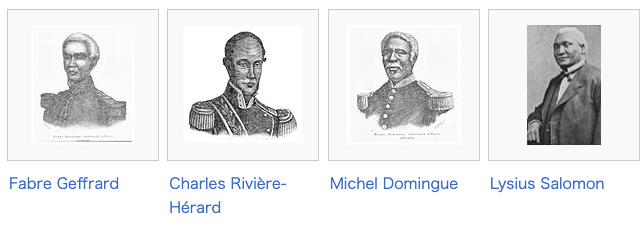 |
政治闘争 (1843-1915) 1849年、ハイチ王ファウスティン1世の戴冠式  1868年、サルナベの反乱で焼失した国民宮殿  1900年、ハイチのポルトープランスにあるドイツ公使館とハンブルク・アメリカライン代理店のスタッフ。代理店は公使館の人員配置と管理に携わっていた。ドイツ国民はハイチで比較的多く、第一次世界大戦までハイチ経済に深く関わっていた。  1907年、キャップハイティエンの司教館 1843年、シャルル・リヴィエール=エラール率いる反乱軍がボワイエを打倒し、1843年憲法の下、短期間の議会統治を確立した。やがて反乱が勃発し、 ハイチはほぼ混乱状態に陥った。1847年3月、1791年の反乱で戦った元奴隷のファウスティン・スールーク将軍が大統領に就任するまで、一過性の大統 領が続いた。この間、ハイチはドミニカ共和国との戦争に失敗した。 1849年、ファウスティン・スールーク大統領はその人気に乗じて皇帝ファウスティン1世を宣言した。彼の鉄の支配は一時期ハイチを統一することに成功したが、1859年、タバラ公爵と呼ばれたファーブル・ゲフラール将軍によって退位させられ、突然終わりを告げた。 ゲフラールの軍政は1867年まで続き、彼は国民和解政策を推進し成功を収めた。1860年、彼はバチカンと協定を結び、学校を含むローマ・カトリックの 公的機関を再び国内に導入した。1867年には立憲政府の樹立が試みられたが、歴代の大統領シルヴァン・サルナーヴとニサージュ・サジェはそれぞれ 1869年と1874年に倒された。1874年、ミシェル・ドミンゲの下でより実行可能な憲法が導入され、ハイチは民主的な平和と発展の長い時代を迎える ことになった。1879年にはフランスへの債務がようやく返済され、ピエール・テオマ・ボワロン=カナル大統領の政府は、ハイチの優れた指導者の一人であ るリシウス・サロモンに平和的に政権を移譲した。1880年から1881年にかけてハイチ国民銀行が設立され、金融改革が行われ、ハイチ芸術の開花ととも に文化的ルネッサンスが起こった。 19世紀最後の20年間は、ハイチの知的文化の発展も顕著であった。1847年と1865年には、歴史に関する主要な著作が出版された。ルイ=ジョゼフ・ ジャンヴィエとアンテノール・フィルマンに率いられたハイチの知識人たちは、この時期に台頭した人種主義や社会ダーウィニズムの潮流に対抗して、書簡戦争 を繰り広げた。 1867年に制定された憲法は、平和的で進歩的な政権交代をもたらし、ハイチ国民の経済と安定、そして国民の状態を改善するために大いに貢献した。立憲政 治は、法的制度に対するハイチ国民の信頼を回復した。ポルトープランス近郊で砂糖とラム酒の工業が発展し、ハイチはしばらくの間、ラテンアメリカ諸国の経 済成長のモデルとなった。1911年に革命が勃発し、ハイチは再び混乱と負債に陥った。 1911年から1915年にかけて、6人の異なる大統領が誕生したが、いずれも殺害されるか亡命させられた[62]。革命軍は、北部の山間部、多孔質のド ミニカ国境沿いの農民の山賊であるカコスによって編成され、彼らは革命成功後に支払われる金と略奪の機会を約束され、対立する政治派閥によって入隊させら れた。 アメリカは特に、不釣り合いな経済力を持つハイチのドイツ人社会(1910年当時約200人)の役割を懸念していた。ドイツ人はハイチの国際商業の約 80%を支配し、キャップ・ハイチとポルトープランスの公共事業、首都の主要埠頭と路面電車、カルデュサック平野を走る鉄道も所有・運営していた。 ドイツ人社会は、フランス人を含む他のどの白人外国人グループよりもハイチ社会に積極的に溶け込もうとした。外国人の土地所有を禁止する憲法を回避して、 国民の有力なマルチーズの家系に嫁いだ者も少なくなかった。彼らはまた、ナショナリズムの主要な資金調達者としても機能し、競合する政治派閥に高利で無数 の融資を行った。 ドイツの影響力を制限するため、1910年から1911年にかけて、アメリカ国務省は、ニューヨーク・ナショナル・シティ銀行が集めたアメリカ人投資家コンソーシアムを支援し、ハイチ共和国国立銀行を通じて通貨発行権を確保した。 1915年2月、ヴィルブラン・ギョーム・サムは独裁体制を確立したが、7月、新たな反乱に直面し、エリート一族出身の政治犯167人を虐殺し、ポルトープランスで暴徒にリンチされた。  |
| United States occupation (1915–1934) Main article: United States occupation of Haiti 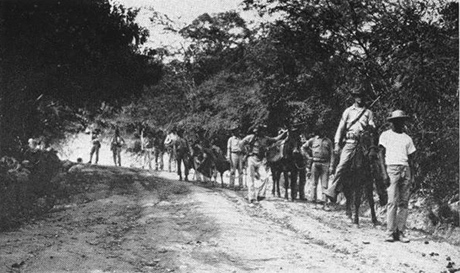 United States Marines and a Haitian guide patrolling the jungle in 1915 during the Battle of Fort Dipitie 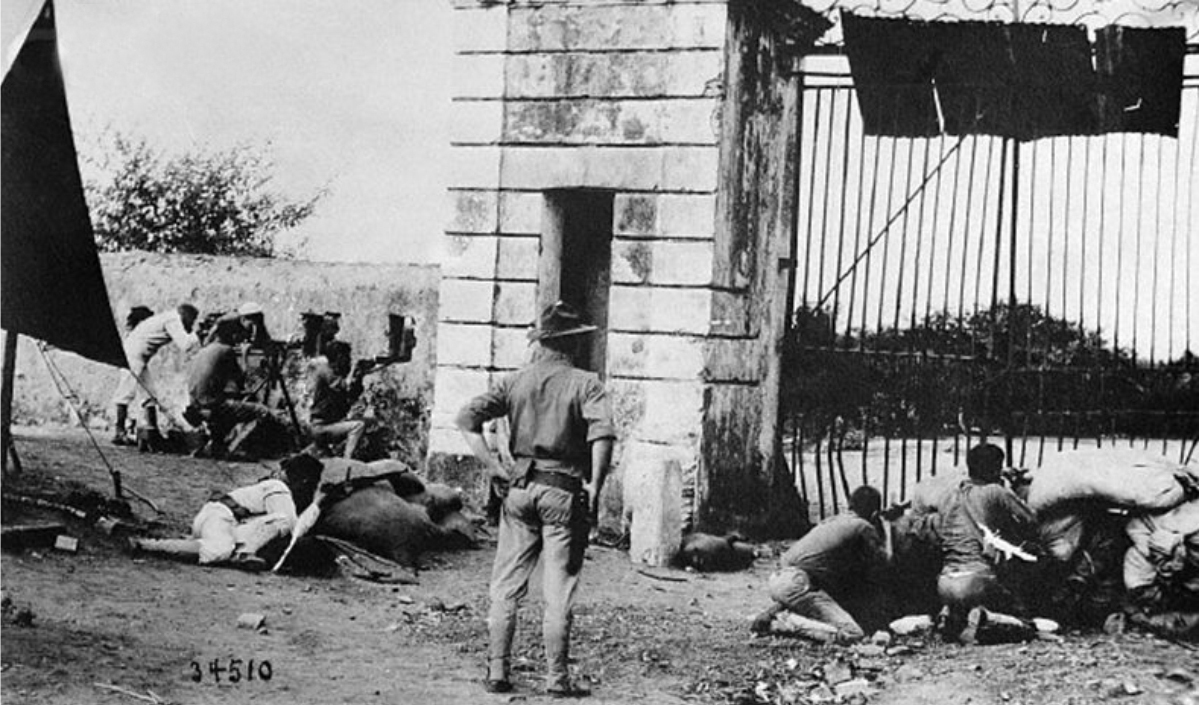 American Marines in 1915 defending the entrance gate in Cap-Haïten 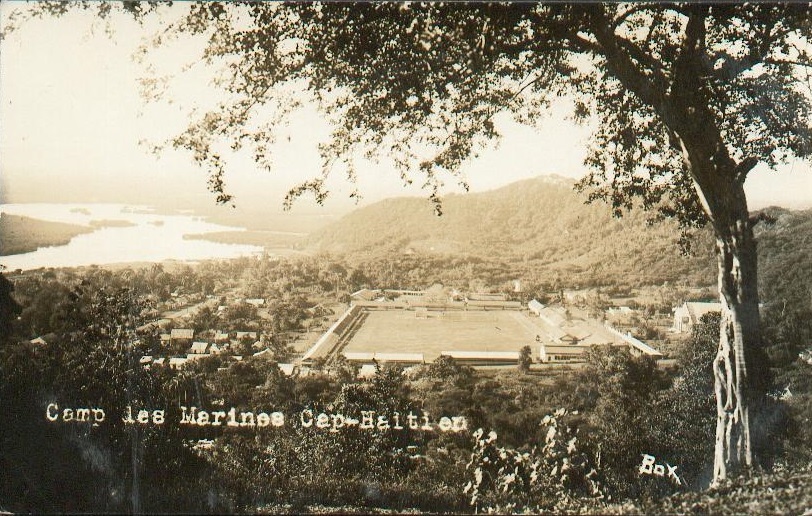 Marine's base at Cap-Haïtien 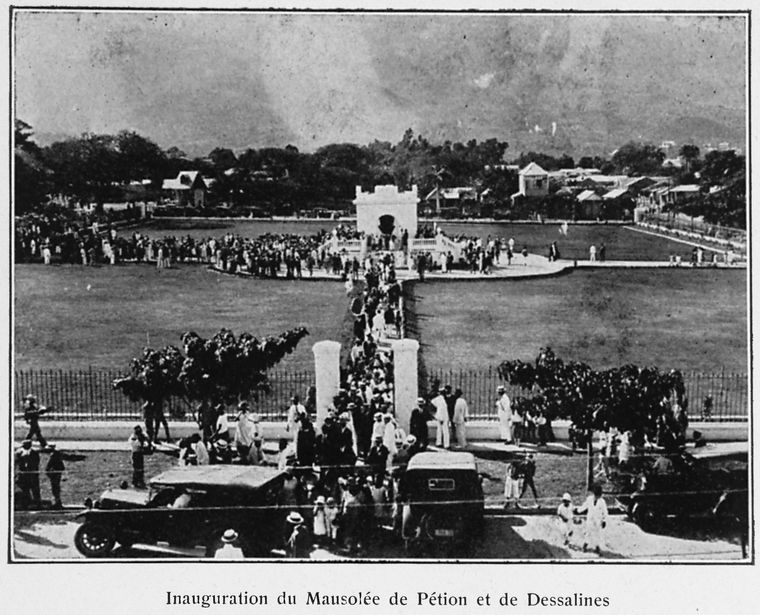 Opening of the mausoleum of Pétion and Dessalines in 1926 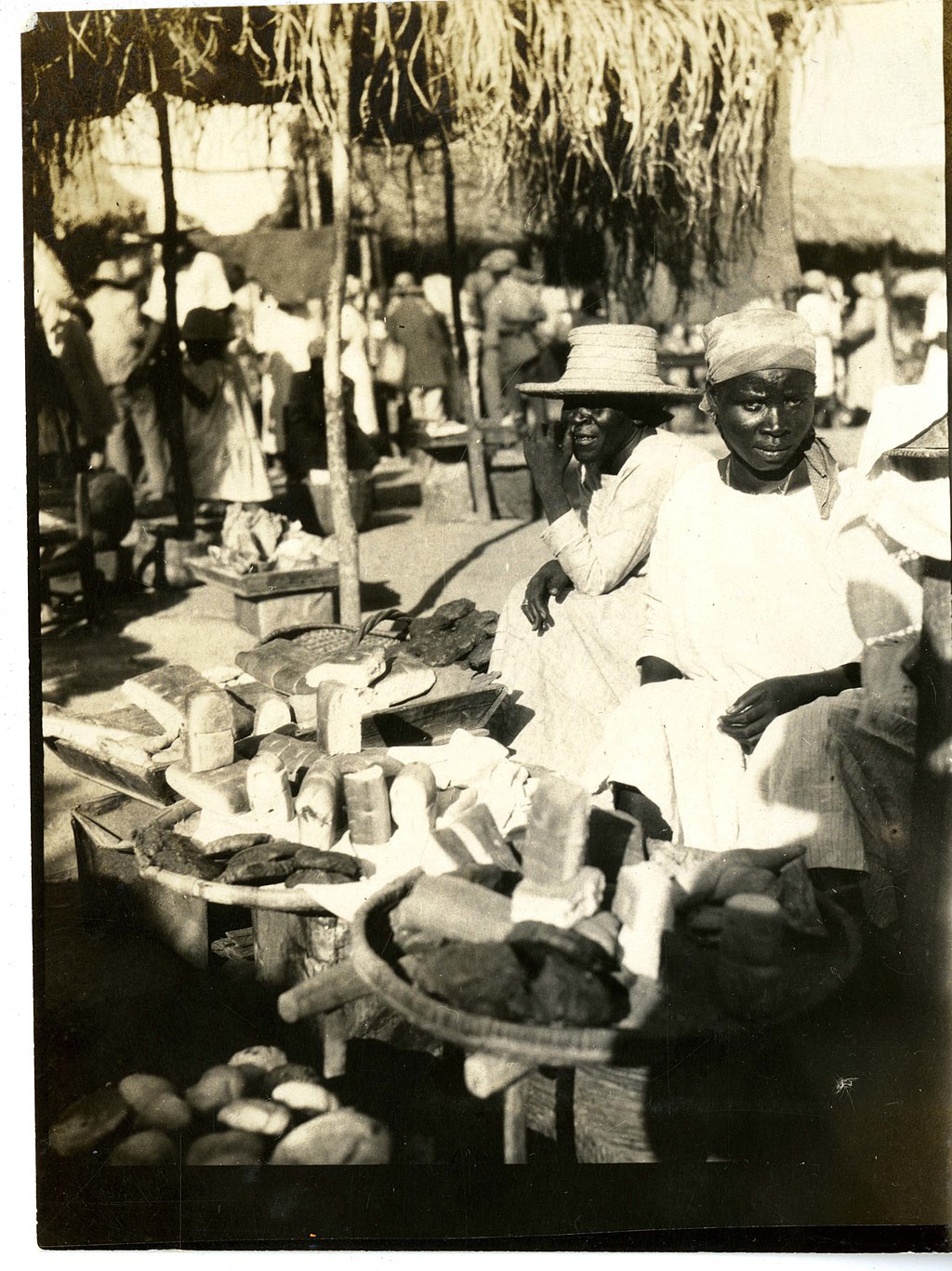 Bread market in St. Michel, 1928–1929 In 1915 the United States, responding to complaints to President Woodrow Wilson from American banks to which Haiti was deeply in debt, occupied the country. The occupation of Haiti lasted until 1934. The US occupation was resented by Haitians as a loss of sovereignty and there were revolts against US forces. Reforms were carried out despite this. Under the supervision of the United States Marines, the Haitian National Assembly elected Philippe Sudré Dartiguenave president. He signed a treaty that made Haiti a de jure US protectorate, with American officials assuming control over the Financial Advisory, Customs Receivership, the Constabulary, the Public Works Service, and the Public Health Service for a period of ten years. The principal instrument of American authority was the newly created Gendarmerie d'Haïti, commanded by American officers. In 1917, at the demand of US officials, the National Assembly was dissolved, and officials were designated to write a new constitution, which was largely dictated by officials in the US State Department and US Navy Department. Franklin D. Roosevelt, Under-Secretary for the Navy in the Wilson administration, claimed to have personally written the new constitution. This document abolished the prohibition on foreign ownership of land – the most essential component of Haitian law. When the newly elected National Assembly refused to pass this document and drafted one of its own preserving this prohibition, it was forcibly dissolved by Gendarmerie commandant Smedley Butler. This constitution was approved by a plebiscite in 1919, in which less than 5% of the population voted. The US State Department authorized this plebiscite presuming that "the people casting ballots would be 97% illiterate, ignorant in most cases of what they were voting for."[63] The Marines and Gendarmerie initiated an extensive road-building program to enhance their military effectiveness and open the country to US investment. Lacking any source of adequate funds, they revived an 1864 Haitian law, discovered by Butler, requiring peasants to perform labor on local roads in lieu of paying a road tax. This system, known as the corvée, originated in the unpaid labor that French peasants provided to their feudal lords. In 1915, Haiti had 3 miles (4.8 km) of road usable by automobile, outside the towns. By 1918, more than 470 miles (760 km) of road had been built or repaired through the corvée system, including a road linking Port-au-Prince to Cap-Haïtien.[64] However, Haitians forced to work in the corvée labor-gangs, frequently dragged from their homes and harassed by armed guards, received few immediate benefits and saw this system of forced labor as a return to slavery at the hands of white men. In 1919, a new caco uprising began, led by Charlemagne Péralte, vowing to 'drive the invaders into the sea and free Haiti.'[65] The Cacos attacked Port-au-Prince in October but were driven back with heavy casualties. Afterwards, a Creole-speaking American Gendarmerie officer and two US marines infiltrated Péralte's camp, killing him and photographing his corpse in an attempt to demoralize the rebels. Leadership of the rebellion passed to Benoît Batraville, a Caco chieftain from Artibonite, who also launched an assault on the capital. His death in 1920 marked the end of hostilities. During Senate hearings in 1921, the commandant of the Marine Corps reported that, in the twenty months of active resistance, 2,250 Haitians had been killed. However, in a report to the Secretary of the Navy he reported the death toll as being 3,250.[66] Haitian historians have estimated the true number was much higher; one suggested, "the total number of battle victims and casualties of repression and consequences of the war might have reached, by the end of the pacification period, four or five times that – somewhere in the neighborhood of 15,000 persons."[67] In 1922, Dartiguenave was replaced by Louis Borno, who ruled without a legislature until 1930. That same year, General John H. Russell, Jr., was appointed High Commissioner. The Borno-Russel dictatorship oversaw the expansion of the economy, building over 1,000 miles (1,600 km) of road, establishing an automatic telephone exchange, modernizing the nation's port facilities, and establishing a public health service. Sisal was introduced to Haiti, and sugar and cotton became significant exports.[68] However, efforts to develop commercial agriculture had limited success, in part because much of Haiti's labor force was employed at seasonal work in the more established sugar industries of Cuba and the Dominican Republic. An estimated 30,000–40,000 Haitian laborers, known as braceros, went annually to the Oriente Province of Cuba between 1913 and 1931.[69] Most Haitians continued to resent the loss of sovereignty. At the forefront of opposition among the educated elite was L'Union Patriotique, which established ties with opponents of the occupation in the US itself, in particular the National Association for the Advancement of Colored People (NAACP).[citation needed] The Great Depression decimated[citation needed] the prices of Haiti's exports and destroyed the tenuous gains of the previous decade. In December 1929, Marines in Les Cayes killed ten Haitians during a march to protest local economic conditions. This led Herbert Hoover to appoint two commissions, including one headed by a former US governor of the Philippines William Cameron Forbes, which criticized the exclusion of Haitians from positions of authority in the government and constabulary, now known as the Garde d'Haïti. In 1930, Sténio Vincent, a long-time critic of the occupation, was elected president, and the US began to withdraw its forces. The withdrawal was completed under US President Franklin D. Roosevelt (FDR), in 1934, under his "Good Neighbor policy". The US retained control of Haiti's external finances until 1947.[70] All three rulers during the occupation came from the country's mulatto minority. At the same time, many in the growing black professional classes departed from the traditional veneration of Haiti's French cultural heritage and emphasized the nation's African roots, most notably ethnologist Jean Price-Mars and the journal Les Griots, edited by Dr. François Duvalier.[71] The transition government was left with a better infrastructure, public health, education, and agricultural development as well as a democratic system. The country had fully democratic elections in 1930, won by Sténio Vincent. The Garde was a new kind of military institution in Haiti. It was a force manned overwhelmingly by blacks, with a United States-trained black commander, Colonel Démosthènes Pétrus Calixte. Most of the Garde's officers, however, were mulattoes. The Garde was a national organization;[72] it departed from the regionalism that had characterized most of Haiti's previous armies. In theory, its charge was apolitical—to maintain internal order, while supporting a popularly elected government. The Garde initially adhered to this role.[72] |
アメリカ合衆国の占領(1915年-1934年) 主な記事 ハイチ占領  1915年、ディピティ要塞の戦いでジャングルをパトロールするアメリカ海兵隊とハイチ人ガイド  1915年、キャップハイテンの入り口ゲートを守るアメリカ海兵隊員  キャップハイティエンでの海兵隊基地  1926年、ペシオンとデッサリーヌの霊廟がオープンする。  サン・ミッシェルのパン市場、1928-1929年 1915年、ハイチが多額の負債を抱えていたアメリカの銀行からウッドロー・ウィルソン大統領に苦情が寄せられ、アメリカはハイチを占領した。ハイチ占領 は1934年まで続いた。アメリカの占領は、主権の喪失としてハイチ人の反感を買い、アメリカ軍に対する反乱が起こった。それでも改革は行われた。 アメリカ海兵隊の監督の下、ハイチ国民議会はフィリップ・スドレ・ダルティグナベを大統領に選出した。彼は、ハイチを実質的にアメリカの保護国とする条約 に調印し、アメリカの役人が10年間、財務顧問、税関管財人、憲兵隊、公共事業サービス、保健サービスを管理することになった。アメリカの権限の主要な手 段は、アメリカ人将校が指揮する新設の国家憲兵隊であった。1917年、アメリカ政府高官の要求により国民議会は解散させられ、新憲法の制定を命じられた が、この憲法はアメリカ国務省とアメリカ海軍省の高官の指示によるものであった。ウィルソン政権の海軍次官だったフランクリン・D・ルーズベルトは、新憲 法を自ら書いたと主張した。この文書は、外国人による土地所有の禁止--ハイチ法の最も重要な構成要素--を廃止した。新しく選出された国民議会がこの文 書の通過を拒否し、この禁止を維持する独自の文書を起草したため、国家憲兵隊司令官スメドリー・バトラーによって強制的に解散させられた。この憲法は 1919年の国民投票によって承認されたが、投票率は人口の5%にも満たなかった。アメリカ国務省は、「投票する人々は97%が読み書きができず、ほとん どの場合、自分たちが何に投票しているのか知らない」[63]と推定して、この国民投票を許可した。 海兵隊と国家憲兵隊は、軍事的効果を高め、米国の投資に国を開放するため、大規模な道路建設計画を開始した。十分な資金源がなかったため、彼らはバトラー によって発見された1864年のハイチの法律を復活させ、道路税を支払う代わりに農民に地方道路での労働を義務付けた。コルヴェとして知られるこの制度 は、フランスの農民が封建領主に提供していた無報酬労働に端を発している。1915年、ハイチには町以外で自動車が通れる道路が3マイル(4.8km)し かなかった。1918年までに、ポルトープランスとキャプハイティエン間を結ぶ道路を含め、470マイル(760km)以上の道路がコルヴェ制度によって 建設または修理された[64]。しかし、コルヴェの労役場で働かされることを余儀なくされたハイチ人は、しばしば家から引きずり出され、武装した警備員に よって嫌がらせを受けたが、すぐに得られる利益はほとんどなく、この強制労働制度を白人の手による奴隷制度への回帰と見なした。 1919年、「侵略者を海に追いやり、ハイチを解放する」と誓ったシャルルマーニュ・ペラルテに率いられた新たなカコの蜂起が始まった[65]。カコは 10月にポルトープランスを攻撃したが、多くの犠牲者を出して追い返された。その後、クレオール語を話すアメリカ国家憲兵隊将校と2人のアメリカ海兵隊員 がペラルテのキャンプに潜入し、反乱軍の士気を下げるために彼を殺害し、その死体を写真に撮った。反乱の主導権はアルティボニテ出身のカコ族族長ブノワ・ バトラヴィルに移り、彼は首都への攻撃も開始した。1920年のバトラヴィルの死により、敵対行為は終結した。1921年の上院公聴会で、海兵隊司令官 は、20ヶ月の活発な抵抗活動で2,250人のハイチ人が殺されたと報告した。しかし、海軍長官への報告では、死者数は3,250人であったと報告してい る[66]。ハイチの歴史家は、本当の数はもっと多かったと推定している。ある歴史家は、「戦闘による犠牲者、弾圧による犠牲者、戦争の結果の犠牲者の総 数は、平和化期間の終わりまでに、その4、5倍、つまり15,000人近辺に達していたかもしれない」と示唆している[67]。 1922年、ダルティゲナブの後任としてルイ・ボルノが就任し、1930年まで立法府なしで統治した。同年、ジョン・H・ラッセル・ジュニア将軍が高等弁 務官に任命された。ボルノ=ラッセル独裁政権は経済の拡大を監督し、1,600kmを超える道路の建設、自動電話交換機の設置、国民の港湾施設の近代化、 保健サービスの確立などを行った。サイザル麻がハイチに導入され、砂糖と綿花が重要な輸出品となった[68]。しかし、商業的農業を発展させる努力は、ハ イチの労働力の多くが、キューバやドミニカ共和国のより確立された砂糖産業で季節労働に従事していたこともあり、限られた成功に終わった。1913年から 1931年にかけて、ブラセロとして知られるハイチ人労働者3万人から4万人が毎年キューバのオリエンテ州に出稼ぎに行ったと推定されている[69]。ほ とんどのハイチ人は、主権の喪失に憤り続けた。教育を受けたエリートの間で反対運動の先頭に立ったのは愛国者同盟で、アメリカ国内の占領反対派、特に有色 人種地位向上国民協会(NAACP)との関係を築いた[要出典]。 世界大恐慌はハイチの輸出価格を壊滅させ[要出典]、それまでの10年間のわずかな利益を破壊した。1929年12月、レ・カイーズの海兵隊が地元の経済 状況に抗議するデモ行進中に10人のハイチ人を殺害した。その結果、ハーバート・フーバーは、元米国フィリピン総督ウィリアム・キャメロン・フォーブスを 委員長とする2つの委員会を任命し、ハイチ人が政府や警察(現在はガルド・ハイティとして知られる)の権威ある地位から排除されていることを批判した。 1930年、長年占領を批判してきたステニオ・ヴィンセントが大統領に選出され、アメリカは軍の撤退を開始した。撤退は1934年、フランクリン・D・ ルーズベルト(FDR)大統領の「善隣政策」の下で完了した。アメリカは1947年までハイチの対外財政を掌握していた[70]。占領下の3人の統治者は いずれも少数民族である混血出身者であった。同時に、成長しつつあった黒人専門家階級の多くは、ハイチのフランス文化遺産に対する伝統的な崇拝から離れ、 国民がアフリカにルーツを持つことを強調した。 移行政府は、より良いインフラストラクチャー、保健、教育、農業開発と民主的なシステムを残した。1930年には完全に民主的な選挙が行われ、ステニオ・ ヴァンサンが勝利した。ガルドはハイチにおける新しいタイプの軍事組織であった。圧倒的に黒人が多く、米国で訓練を受けた黒人司令官デモステーヌ・ペトル ス・カリクテ大佐がいた。しかし、ガルドの将校のほとんどは混血であった。ガルドは国民組織であり[72]、それまでのハイチの軍隊のほとんどを特徴づけ ていたナショナリズムとは一線を画していた。理論的には、ガルドの任務は非政治的であり、民選政府を支持しつつ国内秩序を維持することであった。ガルドは 当初、この役割を堅持していた[72]。 |
| https://en.wikipedia.org/wiki/History_of_Haiti | |
Elections and coups (1934–1957)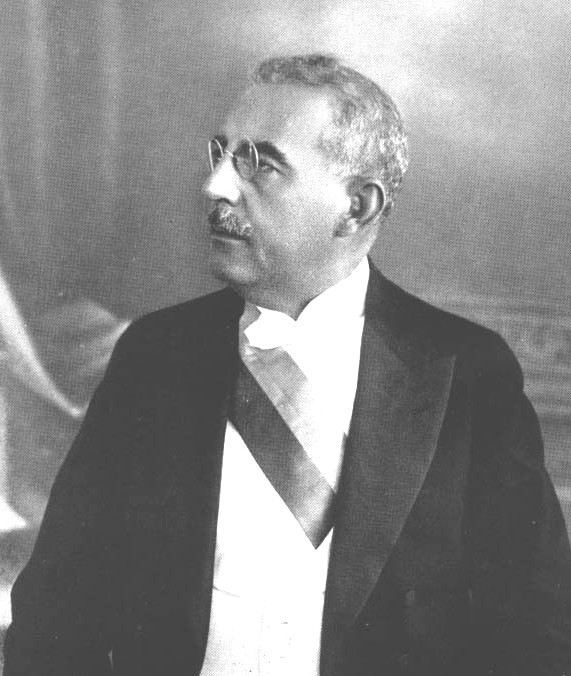 Sténio Vincent Vincent's presidency (1934–1941) President Vincent took advantage of the comparative national stability, which was being maintained by a professionalized military, to gain absolute power. A plebiscite permitted the transfer of all authority in economic matters from the legislature to the executive, but Vincent was not content with this expansion of his power. In 1935 he forced through the legislature a new constitution, which was also approved by plebiscite. The constitution praised Vincent, and it granted the executive sweeping powers to dissolve the legislature at will, to reorganize the judiciary, to appoint ten of twenty-one senators (and to recommend the remaining eleven to the lower house), and to rule by decree when the legislature was not in session. Although Vincent implemented some improvements in infrastructure and services, he brutally repressed his opposition, censored the press, and governed largely to benefit himself and a clique of merchants and corrupt military officers.[72] Under Calixte the majority of Garde personnel had adhered to the doctrine of political nonintervention that their Marine Corps trainers had stressed. Over time, however, Vincent and Dominican dictator Rafael Leónidas Trujillo Molina sought to buy adherents among the ranks. Trujillo, determined to expand his influence over all of Hispaniola, in October 1937 ordered the indiscriminate butchery by the Dominican army of an estimated 14,000 to 40,000 Haitians on the Dominican side of the Massacre River.[73] Some observers claim that Trujillo supported an abortive coup attempt by young Garde officers in December 1937. Vincent dismissed Calixte as commander and sent him abroad, where he eventually accepted a commission in the Dominican military as a reward for his efforts while on Trujillo's payroll. The attempted coup led Vincent to purge the officer corps of all members suspected of disloyalty, marking the end of the apolitical military.[72] |
選挙とクーデター(1934-1957年) ステニオ・ヴァンサン ヴィンセント大統領時代(1934年-1941年) ヴィンセント大統領は、専門化された軍によって維持されていた比較的ナショナリズムの安定を利用して、絶対的な権力を手に入れた。国民投票により、経済に 関するすべての権限が立法府から行政府に移譲されたが、ヴィンセントは権力の拡大に満足しなかった。1935年、彼は立法府に新憲法を強行採決し、これも 国民投票で承認された。この憲法はヴィンセントを賞賛するもので、立法府を自由に解散させ、司法を再編成し、21人の上院議員のうち10人を任命し(残り の11人を下院に推薦する)、立法府が開かれていないときは政令で統治するという大権を行政府に与えた。ヴィンセントはインフラストラクチャーやサービス の改善を実施したものの、反対派を残酷に弾圧し、報道を検閲し、自分自身と商人や腐敗した軍人の徒党の利益のために政治を行った[72]。 カリクスのもとでは、ガルド隊員の大半は、海兵隊の訓練生が強調していた政治不介入の教義を守っていた。しかし時が経つにつれ、ヴィンセントとドミニカの 独裁者ラファエル・レオニダス・トルヒーヨ・モリーナは、隊員の中から信奉者を買おうとした。トルヒーヨはイスパニョーラ全土への影響力拡大を決意し、 1937年10月、ドミニカ軍によるマサクレ川のドミニカ側での推定14,000人から40,000人のハイチ人の無差別虐殺を命じた[73]。1937 年12月、トルヒーヨは若いガルド将校によるクーデター未遂を支援したと主張する者もいる。ヴィンセントはカリクシュテを司令官から解任し、海外に派遣し たが、最終的に彼はトルヒーヨに雇われていた間の努力の報いとしてドミニカ軍での任務を受け入れた。このクーデター未遂事件をきっかけに、ヴィンセントは 不忠誠の疑いのある将校団を粛清し、無政治的な軍隊は終焉を迎えた[72]。 |
Lescot's presidency (1941–1946)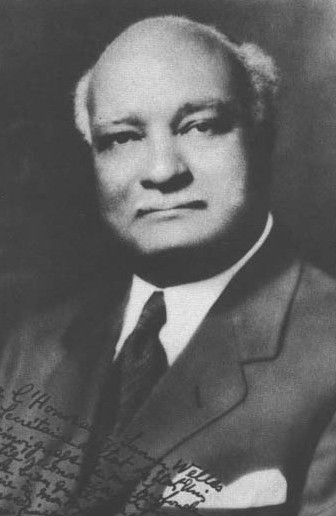 Élie Lescot In 1941 Vincent showed every intention of standing for a third term as president, but after almost a decade of disengagement, the United States made it known that it would oppose such an extension. Vincent accommodated the Roosevelt administration and handed power over to Elie Lescot.[72] Lescot was of mixed race and had served in numerous government posts. He was competent and forceful, and many considered him a sterling candidate for the presidency, despite his elitist background. Like the majority of previous Haitian presidents, however, he failed to live up to his potential. His tenure paralleled that of Vincent in many ways. Lescot declared himself commander in chief of the military, and power resided in a clique that ruled with the tacit support of the Garde. He repressed his opponents, censored the press, and compelled the legislature to grant him extensive powers. He handled all budget matters without legislative sanction and filled legislative vacancies without calling elections. Lescot commonly said that Haiti's declared state-of-war against the Axis powers during World War II justified his repressive actions. Haiti, however, played no role in the war except for supplying the United States with raw materials and serving as a base for a United States Coast Guard detachment.[72] Aside from his authoritarian tendencies, Lescot had another flaw: his relationship with Rafael Trujillo. While serving as Haitian ambassador to the Dominican Republic, Lescot fell under the sway of Trujillo's influence and wealth. In fact, it was Trujillo's money that reportedly bought most of the legislative votes that brought Lescot to power. Their clandestine association persisted until 1943, when the two leaders parted ways for unknown reasons. Trujillo later made public all his correspondence with the Haitian leader. The move undermined Lescot's already dubious popular support.[72] In January 1946, events came to a head when Lescot jailed the Marxist editors of a journal called La Ruche (The Beehive). This action precipitated student strikes and protests by government workers, teachers, and shopkeepers in the capital and provincial cities. In addition, Lescot's mulatto-dominated rule had alienated the predominantly black Garde. His position became untenable, and he resigned on 11 January. Radio announcements declared that the Garde had assumed power, which it would administer through a three-member junta.[72] |
レスコ大統領時代(1941年-1946年) エリー・レスコ 1941年、ヴァンサンは3期目の大統領選挙に立候補する意図主義を示したが、10年近くにわたる不干渉の後、アメリカは大統領任期延長に反対することを明らかにした。ヴァンサンはルーズベルト政権に便宜を図り、エリー・レスコに政権を譲った[72]。 レスコはミヘ人種で、数多くの政府のポストに就いていた。彼は有能で力持ちであり、エリート主義的な経歴にもかかわらず、多くの人々は彼を大統領候補とし て高く評価した。しかし、歴代のハイチ大統領の大半がそうであったように、彼はその潜在能力を発揮することができなかった。彼の在任期間は、多くの点で ヴィンセントと類似していた。レスコは自らを軍の最高司令官と宣言し、権力はガルドの暗黙の支持のもとに支配する徒党に握られた。彼は反対派を弾圧し、報 道を検閲し、立法府に広範な権限を与えるよう強要した。彼は立法府の承認なしにすべての予算問題を処理し、選挙を招集することなく立法府の空席を埋めた。 レスコは、ハイチが第二次世界大戦中に枢軸国に対して宣戦布告していたことが、彼の抑圧的な行動を正当化する理由であるとよく言っていた。しかし、ハイチ は、アメリカに原材料を供給し、アメリカ沿岸警備隊の基地として機能した以外、戦争において何の役割も果たさなかった[72]。 レスコットには、その権威主義的傾向のほかに、ラファエル・トルヒーヨとの関係というもうひとつの欠点があった。ドミニカ共和国のハイチ大使を務めていた とき、レスコットはトルヒーヨの影響力と富の支配下に置かれた。実際、レスコットに権力をもたらした立法府の票の大半を買ったのは、トルヒーヨの金だった と言われている。2人の秘密の関係は1943年まで続いたが、2人の指導者は理由もわからず決別した。トルヒーヨは後にハイチ人指導者との書簡をすべて公 開した。この動きは、すでに怪しかったレスコットの民衆の支持を弱めた[72]。 1946年1月、レスコットがラ・リューシュ(蜂の巣)という雑誌のマルクス主義者編集者を投獄したことで事態は収束に向かった。この行動は、首都や地方 都市における学生ストライキや公務員、教師、商店主による抗議行動を引き起こした。さらに、レスコの混血支配は、黒人の多いガルドを疎外した。レスコの立 場は危うくなり、1月11日に辞任した。ラジオのアナウンスでは、ガルドが権力を掌握し、3人の議員からなる純政権によって統治すると宣言された [72]。 |
Revolution of 1946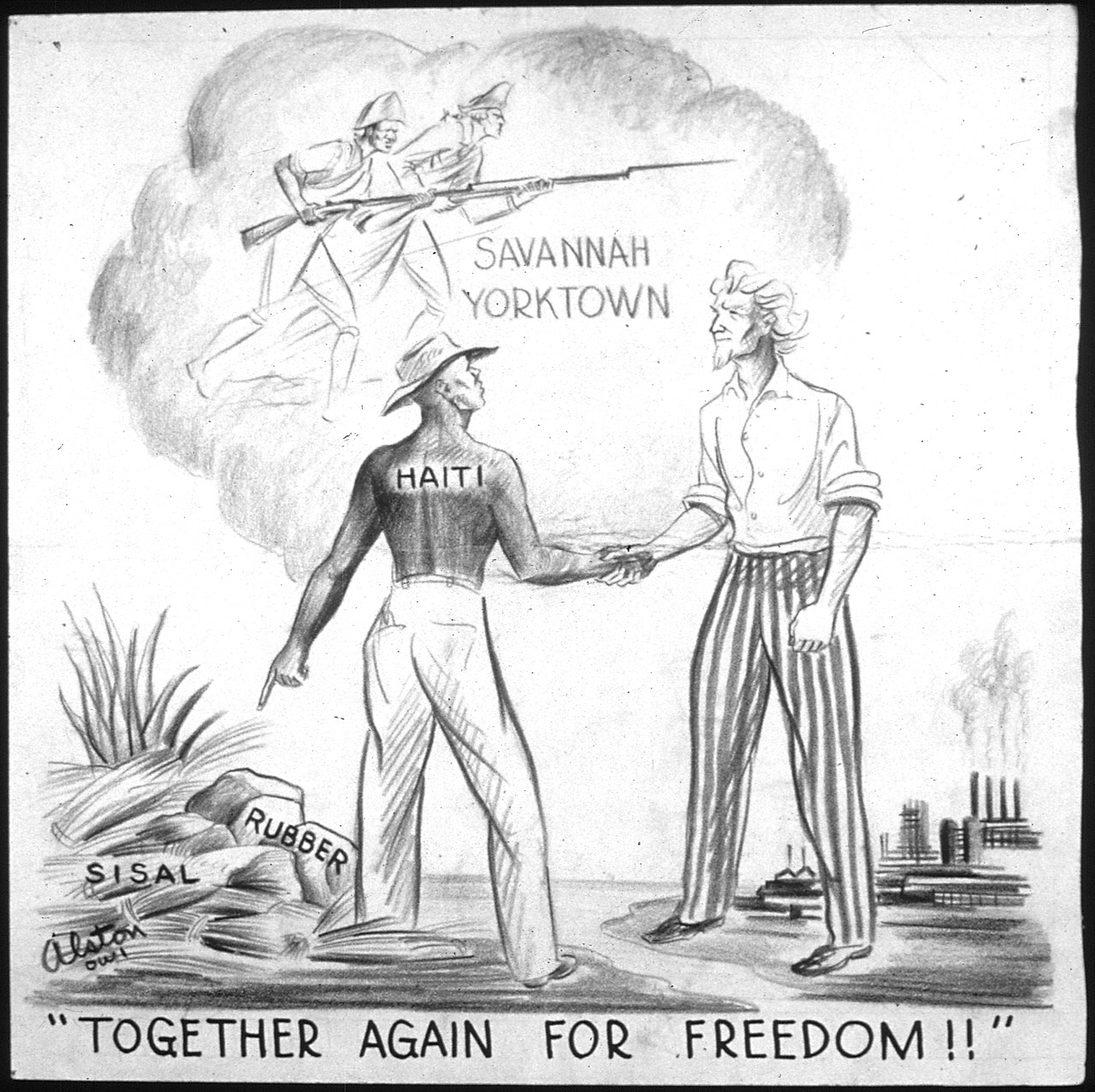 "Together again for freedom", 1943 U.S. leaflet The Revolution of 1946 was a novel development in Haiti's history, as the Garde assumed power as an institution, not as the instrument of a particular commander. The members of the junta, known as the Military Executive Committee (Comité Exécutif Militaire), were Garde commander Colonel Franck Lavaud, Major Antoine Levelt, and Major Paul E. Magloire, commander of the Presidential Guard. All three understood Haiti's traditional way of exercising power, but they lacked a thorough understanding of what would be required to make the transition to an elected civilian government. Upon taking power, the junta pledged to hold free elections. The junta also explored other options, but public clamor, which included public demonstrations in support of potential candidates, eventually forced the officers to make good on their promise.[72] Haiti elected its National Assembly in May 1946. The Assembly set 16 August 1946, as the date on which it would select a president. The leading candidates for the office—all of whom were black—were Dumarsais Estimé, a former school teacher, assembly member, and cabinet minister under Vincent; Félix d'Orléans Juste Constant, leader of the Haitian Communist Party (Parti Communiste d'Haïti—PCH); and former Garde commander Démosthènes Pétrus Calixte, who stood as the candidate of a progressive coalition that included the Worker Peasant Movement (Mouvement Ouvrier Paysan—MOP). MOP chose to endorse Calixte, instead of a candidate from its own ranks, because the party's leader, Daniel Fignolé, was only thirty-three years old—too young to stand for the nation's highest office. Estimé, politically the most moderate of the three, drew support from the black population in the north, as well as from the emerging black middle class. The leaders of the military, who would not countenance the election of Juste Constant and who reacted warily to the populist Fignolé, also considered Estimé the safest candidate. After two rounds of polling, legislators gave Estimé the presidency.[72] |
1946年の革命 「自由のために再び共に」、1943年の米国のビラ 1946年の革命はハイチの歴史において斬新な展開であった。ガルドが特定の司令官の道具としてではなく、組織として権力を握ったからである。軍事執行委 員会(Comité Exécutif Militaire)として知られる軍閥のメンバーは、ガルド司令官のフランク・ラヴォー大佐、アントワーヌ・レベルト少佐、大統領警護隊司令官のポー ル・E・マグロワール少佐だった。3人ともハイチの伝統的な権力行使の方法を理解していたが、選挙で選ばれた文民政府への移行に何が必要かを十分に理解し ていなかった。政権を奪取したとき、民政党は自由選挙の実施を約束した。盟約者団は他の選択肢も検討したが、候補者候補を支持する市民デモを含む市民の喧 騒によって、結局、盟約者団は約束を果たすことを余儀なくされた[72]。 ハイチは1946年5月に国民議会を選出した。国民議会は1946年8月16日を大統領選出の日と定めた。大統領選の有力候補は、元学校教師で下院議員、 ヴァンサン政権下で閣僚を務めたドゥマルサイ・エスティメ、ハイチ共産党(Parti Communiste d'Haïti-PCH)党首のフェリックス・ドルレアン・ジュスト・コンスタン、労働者農民運動(Mouvement Ouvrier Paysan-MOP)を含む進歩的連合の候補として立候補した元ガルド司令官のデモステーヌ・ペトルス・キャリクスの3人で、いずれも黒人だった。 MOPは、党首ダニエル・フィニョレがまだ33歳で、ナショナリズムの最高権力者になるには若すぎたため、党内の候補者ではなくカリクスを推薦した。エス ティメは政治的には3人の中で最も穏健で、北部の黒人住民や新興の黒人中産階級から支持を集めた。ジュスト・コンスタンの当選を容認せず、ポピュリストの フィニョレを警戒していた軍の指導者たちも、エスティメが最も安全な候補者だと考えていた。2回の投票の後、議員たちはエスティメに大統領職を与えた [72]。 |
| https://en.wikipedia.org/wiki/History_of_Haiti |
リ ンク
ゾ ンビリンク
文 献
そ の他の情報
Copyleft, CC, Mitzub'ixi Quq Chi'j, 1996-2099
☆
 ☆
☆